Florida’s natural landscapes are home to an astonishing variety of birds of prey, or raptors, that play a crucial role in the ecosystem. These birds are masters of the skies, with sharp eyesight, powerful talons, and excellent hunting abilities that allow them to regulate populations of smaller animals. This article delves into the fascinating world of Florida’s raptors, examining their habits, unique adaptations, and importance to the environment.
Birds of Prey in Florida List
Hawks of Florida
- Red-shouldered Hawk
- Red-tailed Hawk
- Cooper’s Hawk
- Sharp-shinned Hawk
- Broad-winged Hawk
- Northern Harrier
- Short-tailed Hawk
- Swainson’s Hawk
Florida’s Eagles
- Bald Eagle
- Golden Eagle
- White-tailed Eagle
Vultures: Nature’s Clean-up Crew
- Black Vulture
- Turkey Vulture
Owls: Nocturnal Predators
- Great Horned Owl
- Barred Owl
- Eastern Screech-Owl
- Burrowing Owl
- Barn Owl
- Short-eared Owl
- Northern Saw-whet Owl
Falcons: Speed and Agility in the Sky
- American Kestrel
- Peregrine Falcon
- Merlin
- Crested Caracara
- Aplomado Falcon
Kites: Graceful Aerial Hunters
- Swallow-tailed Kite
- Mississippi Kite
- Snail Kite
- White-tailed Kite
- Hook-billed Kite
1. Introduction to Raptors in Florida
Raptors are birds of prey equipped with remarkable hunting skills, including sharp talons, keen eyesight, and hooked beaks. They play an essential role in keeping ecosystems balanced by controlling populations of smaller animals such as rodents, reptiles, and birds. In Florida, with its varied ecosystems ranging from wetlands and forests to grasslands and coastal areas, many species of raptors thrive both as residents and migratory visitors.
2. Hawks of Florida
Hawks are some of Florida’s most recognized raptors, known for their soaring abilities, sharp talons, and excellent eyesight. Each hawk species plays a specific role in controlling prey populations, making them critical to the ecological balance of Florida’s diverse habitats.
Red-shouldered Hawk (Buteo lineatus)
Size: 43-61 cm (16.9-24 in)
Weight: 486-774 g (17.1-27.3 oz)
Lifespan: Around 10-20 years
Diet: Small mammals, reptiles, amphibians, birds

Appearance
The Red-shouldered Hawk is known for its striking reddish-brown shoulders and barred reddish chest. Its back and wings have a mix of black and white patterns. Both males and females look similar, though females are slightly larger. Their sharp talons and hooked beaks make them skilled hunters.
Migration Habits
Red-shouldered Hawks are mostly non-migratory, especially in places like Florida and the southeastern U.S. They tend to stay in their territory year-round. However, hawks in colder northern regions may migrate south to avoid harsh winters.
Nesting
These hawks build their nests high up in tall trees, usually near water like rivers or wetlands. They use sticks to form the structure and line it with soft materials like leaves and moss. Female hawks lay 2-4 eggs, and both parents take turns protecting and feeding the young.
Feeding Behavior
Red-shouldered Hawks are expert hunters. They often sit on high branches, carefully watching for prey such as small mammals, frogs, snakes, or birds. When they spot their prey, they swoop down quickly to grab it with their strong talons.
Behavior and Personality
These hawks are known for their loud, sharp calls, which they use to communicate throughout their territory. They are territorial, especially during the breeding season, and often defend their space aggressively. They are also powerful fliers and can often be seen soaring high above their territory.
Habitat
Red-shouldered Hawks prefer living in forests, woodlands, and areas near water, such as rivers or marshes. They also adapt well to suburban areas with plenty of trees. Once they find a good spot, they often return to the same nesting site year after year.
| Category | Details |
|---|---|
| Status | Least Concern |
| State Status | Common in the eastern U.S., including Florida |
| Wingspan | 94-111 cm (37-44 in) |
| Sound | Loud, repeated “kee-ah” calls |
| Appearance | Reddish shoulders, barred reddish chest, and black-and-white patterned wings and tail |
Red-tailed Hawk (Buteo jamaicensis)
Size: 45-65 cm (17.7-25.6 in)
Weight: 690-1460 g (24.3-51.5 oz)
Lifespan: Around 10-21 years
Diet: Small mammals, birds, reptiles

Appearance
The Red-tailed Hawk is easily recognized by its striking rusty-red tail, which is especially vivid in adult birds. It has a brown body with lighter underparts, often featuring a “belly band” of darker feathers. Their broad wings and strong talons make them powerful fliers and hunters.
Migration Habits
While some Red-tailed Hawks are year-round residents, especially in warmer regions like Florida, others migrate south during the winter. Hawks from northern regions travel to the southern U.S., Mexico, and Central America to avoid the cold.
Nesting
Red-tailed Hawks build large nests made of sticks in tall trees or sometimes on cliff edges. The nests are lined with softer materials like bark and leaves. Females usually lay 1-3 eggs, and both parents work together to raise the young, with the female incubating the eggs and the male hunting for food.
Feeding Behavior
Red-tailed Hawks are skilled hunters, typically feeding on small mammals like mice, rats, and rabbits, but they also hunt birds and reptiles. They often perch in high places, scanning the ground for prey before swooping down swiftly to capture it with their sharp talons.
Behavior and Personality
Red-tailed Hawks are known for their powerful soaring flight and their ability to ride thermals high in the sky. They are also quite vocal, often heard making a distinctive, high-pitched scream. They are territorial birds, especially during the breeding season, and will defend their nests aggressively.
Habitat
Red-tailed Hawks are highly adaptable and can live in a variety of environments, including forests, grasslands, deserts, and even urban areas. They are often seen perched on power lines or trees near open fields where they can easily spot prey.
| Category | Details |
|---|---|
| Status | Least Concern |
| State Status | Common throughout the U.S., including Florida |
| Wingspan | 114-133 cm (45-52 in) |
| Sound | Loud, raspy scream |
| Appearance | Brown body with a distinctive red tail and lighter underparts with a darker belly band |
Cooper’s Hawk (Accipiter cooperii)
Size: 37-45 cm (14.6-17.7 in)
Weight: 220-680 g (7.8-24 oz)
Lifespan: Around 12 years
Diet: Small birds, mammals, insects
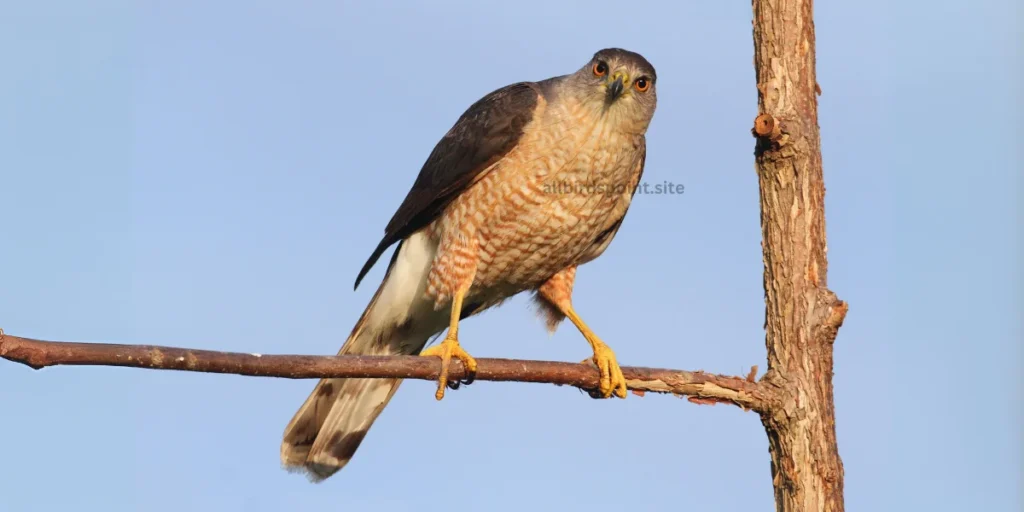
Appearance
Cooper’s Hawks have a sleek, medium-sized body with a slate-gray back and wings, reddish-brown barring on their chest, and striking red eyes in adults. Their long, rounded tail helps them navigate through dense forests with agility. Juveniles have more brown streaks on their chest and yellow eyes.
Migration Habits
Cooper’s Hawks are mostly year-round residents in the central and northern U.S., including parts of Florida. In colder regions, some hawks migrate south for the winter, but those in milder climates, like the southeastern U.S., tend to stay in place.
Nesting
These hawks build their nests high in tall trees, often hidden within thick foliage. The nests are made of sticks and lined with bark, feathers, or leaves. Females lay 2-4 eggs, and both parents care for the chicks, with the male providing food while the female guards the nest.
Feeding Behavior
Cooper’s Hawks are swift and agile hunters, often preying on smaller birds like pigeons, starlings, and robins, though they also eat small mammals like squirrels and chipmunks. They use stealth and surprise to catch their prey, often flying through trees with incredible speed.
Behavior and Personality
Cooper’s Hawks are known for their fierce and aggressive hunting style. They are very territorial, especially during breeding season, and can be quite bold in defending their territory. Their flight is fast and direct, often involving short bursts of speed as they chase their prey through trees or across open spaces.
Habitat
These hawks thrive in forests, woodlands, and even suburban areas where there are plenty of trees and birds to hunt. They are common in neighborhoods with mature trees and gardens, where bird feeders attract their prey.
| Category | Details |
|---|---|
| Status | Least Concern |
| State Status | Common in the U.S., including parts of Florida |
| Wingspan | 62-90 cm (24-35 in) |
| Sound | Short, harsh “cak-cak-cak” calls |
| Appearance | Slate-gray back, reddish-brown barred chest, and red eyes in adults; brown streaks and yellow eyes in juveniles |
Sharp-shinned Hawk (Accipiter striatus)
Size: 24-34 cm (9.4-13.4 in)
Weight: 87-218 g (3.1-7.7 oz)
Lifespan: Around 3-5 years
Diet: Small birds, insects, small mammals

Appearance
Sharp-shinned Hawks are the smallest hawks in North America. They have a slate-gray back and wings, with reddish-orange barring on their chest and underparts. Like other accipiters, they have a long, square-tipped tail that helps them maneuver quickly through dense forests. Juveniles are brown with streaked underparts.
Migration Habits
Sharp-shinned Hawks are migratory in northern regions, traveling south during the winter to warmer climates, including Florida. In southern areas, some populations may remain year-round. They migrate in large numbers along ridges and coasts during the fall.
Nesting
These hawks build their nests in dense coniferous or mixed forests, often high in trees. The nests are constructed from twigs and lined with softer materials like bark or feathers. Females typically lay 3-8 eggs, and both parents help feed and care for the young.
Feeding Behavior
Sharp-shinned Hawks primarily hunt small birds such as sparrows and finches. They rely on their speed and agility to chase prey through trees and shrubs, often catching their meal mid-air. They are stealthy hunters, perching quietly before launching a surprise attack.
Behavior and Personality
Despite their small size, Sharp-shinned Hawks are fierce predators. They are known for their fast, erratic flight as they pursue prey, often weaving through trees with precision. These hawks are shy and elusive, making them harder to spot compared to larger raptors.
Habitat
Sharp-shinned Hawks prefer dense forests, particularly coniferous forests, but they can also be found in mixed woodlands and suburban areas with enough tree cover. During migration, they are often seen soaring along ridgelines or near coasts.
| Category | Details |
|---|---|
| Status | Least Concern |
| State Status | Common in the U.S., winter visitor in Florida |
| Wingspan | 43-56 cm (17-22 in) |
| Sound | High-pitched, rapid “kik-kik-kik” calls |
| Appearance | Slate-gray back, reddish-orange barred chest in adults; brown streaked underparts in juveniles |
Broad-winged Hawk (Buteo platypterus)
Size: 34-44 cm (13.4-17.3 in)
Weight: 265-560 g (9.3-19.8 oz)
Lifespan: Around 12 years
Diet: Small mammals, reptiles, amphibians, insects
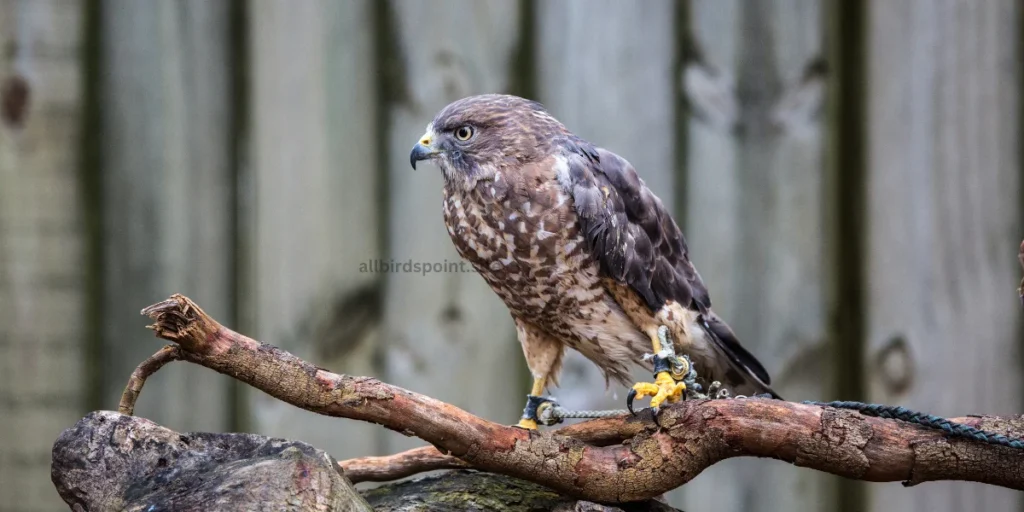
Appearance
The Broad-winged Hawk is a medium-sized hawk with a compact body. Adults have a brown back, a pale underside, and distinctive broad black and white bands on their tail, making them easy to identify in flight. Their wings are broad and rounded, which helps them glide efficiently. Juveniles have streaked underparts and less distinct tail markings.
Migration Habits
Broad-winged Hawks are well-known for their spectacular migrations. Every fall, thousands of these hawks travel from North America to Central and South America, forming large groups known as “kettles.” Florida is an important stopover point during their migration. In spring, they return to their breeding grounds in the northern U.S. and Canada.
Nesting
Broad-winged Hawks build their nests in deciduous or mixed forests, usually placing them high in trees. The nests are made of sticks and lined with soft materials like moss and leaves. Females lay 1-3 eggs, and both parents share the responsibility of feeding and raising the chicks.
Feeding Behavior
Broad-winged Hawks hunt from a perch, often waiting patiently in the trees before swooping down to capture their prey. They primarily feed on small mammals like mice and voles, but they also hunt reptiles, amphibians, and large insects. Their diverse diet helps them adapt to different environments during migration.
Behavior and Personality
These hawks are relatively secretive during the breeding season, staying hidden in dense forests. However, during migration, they are very social, often seen in large groups soaring on thermal currents. Their flight during migration is graceful and smooth, with minimal flapping.
Habitat
Broad-winged Hawks prefer dense forests, particularly deciduous and mixed woodlands, where they breed and hunt. They are rarely seen in open areas. During migration, they can be observed in a variety of habitats, including forests, fields, and coastal areas as they move toward their wintering grounds.
| Category | Details |
|---|---|
| Status | Least Concern |
| State Status | Migratory species, common during fall and spring in Florida |
| Wingspan | 81-100 cm (32-39 in) |
| Sound | High-pitched whistle “pee-eee” |
| Appearance | Brown back, pale underside, and black-and-white banded tail |
Northern Harrier (Circus hudsonius)
Size: 46-50 cm (18.1-19.7 in)
Weight: 300-750 g (10.6-26.5 oz)
Lifespan: Around 7-10 years
Diet: Small mammals, birds, amphibians
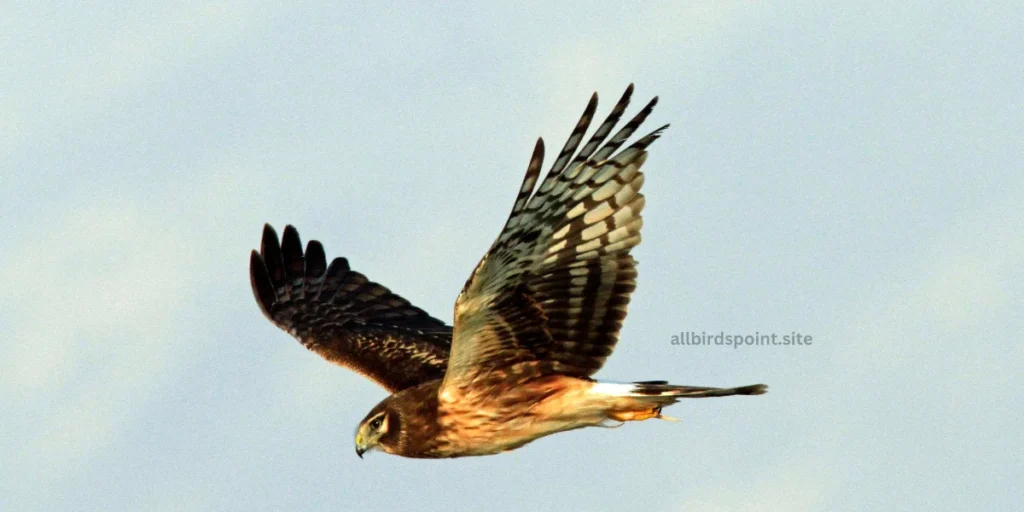
Appearance
The Northern Harrier is a slender, medium-sized hawk with long wings and a long tail. It is easily recognized by its owl-like facial disk, which helps it hear prey moving in the grass. Males are gray with white underparts, while females and juveniles are brown with streaked underparts. Both sexes have a prominent white rump patch, visible during flight.
Migration Habits
Northern Harriers are migratory birds, moving south in the winter to places like Florida, while breeding in the northern U.S. and Canada. They prefer open habitats during migration and are often seen flying low over marshes, fields, and grasslands in search of prey.
Nesting
These hawks build their nests on the ground in thick vegetation, such as marshes or tall grasslands. The nests are made of sticks and grasses, providing protection for the 4-6 eggs the female lays. Both parents care for the young, with the male often hunting while the female stays at the nest.
Feeding Behavior
Northern Harriers are unique hunters that fly low over the ground, using both their vision and hearing to locate prey. They primarily feed on small mammals like voles and mice, but they also catch birds and amphibians. Their owl-like facial disk enhances their ability to hear prey moving in the vegetation.
Behavior and Personality
Northern Harriers are graceful, low-flying raptors often seen gliding over fields and marshes in search of food. They are solitary hunters and can cover large areas while searching for prey. Their distinctive flight pattern, which involves slow, methodical wing beats, sets them apart from other hawks.
Habitat
These hawks prefer open habitats like marshes, wetlands, grasslands, and agricultural fields. They rely on dense vegetation for nesting and hunting and are commonly seen in these areas during migration and winter months in Florida.
| Category | Details |
|---|---|
| Status | Least Concern |
| State Status | Common winter visitor in Florida |
| Wingspan | 102-118 cm (40-46 in) |
| Sound | Soft, short “kek-kek-kek” calls |
| Appearance | Males are gray with white underparts, females and juveniles are brown with streaked underparts, both with a white rump patch |
Short-tailed Hawk (Buteo brachyurus)
Size: 39-44 cm (15.3-17.3 in)
Weight: 385-480 g (13.6-16.9 oz)
Lifespan: Around 10 years
Diet: Small birds, reptiles, mammals

Appearance
The Short-tailed Hawk is a medium-sized raptor with two distinct color morphs: the dark morph, which has mostly dark brown or black feathers, and the light morph, which has white underparts and a darker back and wings. Both morphs share the characteristic short tail and long wings, making them efficient at soaring. Their tails and underwings often have distinctive banding.
Migration Habits
Short-tailed Hawks are mostly non-migratory in southern Florida, where they can be seen year-round. They are more common in South Florida and the Everglades, but some migrate to Central and South America during colder months.
Nesting
These hawks typically nest in tall trees, often near open areas or wetlands. They build their nests from sticks and line them with softer materials like leaves and moss. Females lay 1-3 eggs, and both parents contribute to raising the chicks.
Feeding Behavior
Short-tailed Hawks are specialized hunters of small birds, often catching them in mid-air. They soar high above forests and open areas, using their sharp vision to spot prey. They are also known to hunt reptiles and small mammals, though birds are their primary food source.
Behavior and Personality
These hawks are known for their soaring flight and keen hunting skills. They can often be seen circling high in the sky before diving down to capture prey. Unlike other raptors, they are not as aggressive or territorial, and they can often be found in areas with other hawks.
Habitat
Short-tailed Hawks prefer open woodlands, wetlands, and areas near forests. They are often seen in southern Florida, particularly in the Everglades, but are also found in parts of Central and South America. These birds tend to favor areas with tall trees for nesting and open spaces for hunting.
| Category | Details |
|---|---|
| Status | Least Concern |
| State Status | Common year-round in southern Florida |
| Wingspan | 83-103 cm (33-40.5 in) |
| Sound | High-pitched whistles |
| Appearance | Dark morph: dark brown or black; light morph: white underparts with dark back and wings |
Swainson’s Hawk (Buteo swainsoni)
Size: 46-56 cm (18-22 in)
Weight: 700-1400 g (24.7-49.4 oz)
Lifespan: Around 16-19 years
Diet: Small mammals, insects, birds, reptiles
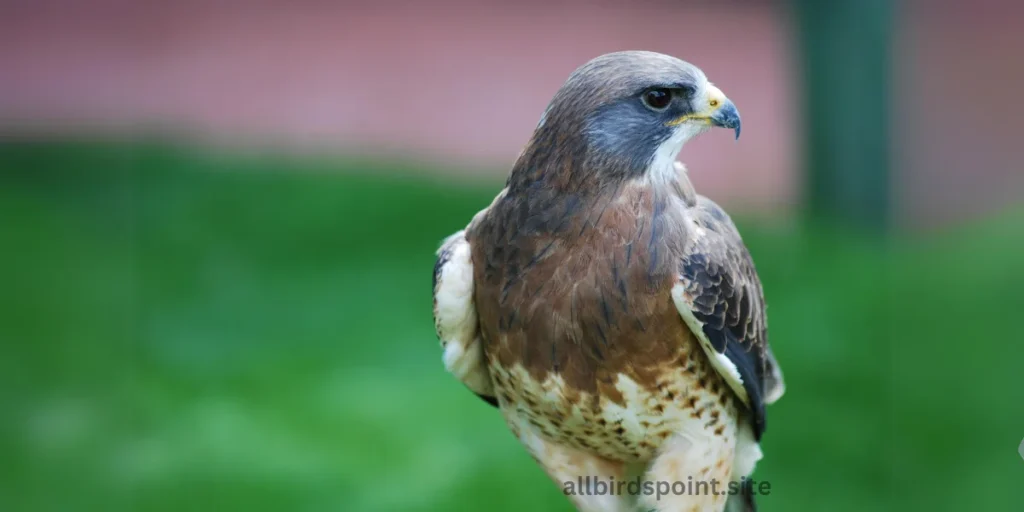
Appearance
Swainson’s Hawk is a medium to large-sized hawk with long, narrow wings and a short tail. Adults have a dark brown or grayish-brown back and upper wings, with a lighter underside and contrasting darker chest. Their wings show a distinct two-tone pattern during flight, with dark flight feathers and lighter wing linings. Juveniles are paler with streaks on their chest and belly.
Migration Habits
Swainson’s Hawks are known for their long migrations, traveling from their breeding grounds in North America to wintering areas in South America, covering up to 12,000 miles round trip. They migrate in large flocks, often forming groups called “kettles” during their journey. Florida is not part of their core range, but some individuals pass through the state during migration.
Nesting
These hawks typically nest in open grasslands, agricultural areas, and prairies, often using trees or shrubs as nesting sites. The nests are constructed from sticks and lined with softer materials like grass. Females lay 1-4 eggs, and both parents care for the chicks. During nesting season, they aggressively defend their territory.
Feeding Behavior
Swainson’s Hawks have a varied diet, feeding primarily on small mammals such as ground squirrels, rabbits, and mice during the breeding season. However, during migration, they rely heavily on insects, particularly grasshoppers and dragonflies. This shift in diet allows them to cover long distances without needing to hunt larger prey.
Behavior and Personality
Swainson’s Hawks are social birds, often seen in large groups during migration. They are agile fliers and can cover great distances with minimal effort, often soaring on thermals. They are relatively peaceful and less territorial than other hawks, especially outside of the breeding season.
Habitat
Swainson’s Hawks prefer open habitats such as grasslands, prairies, and agricultural fields. They are not commonly found in dense forests or heavily urbanized areas. During migration, they are often seen flying over a variety of landscapes, from deserts to coastal areas.
| Category | Details |
|---|---|
| Status | Least Concern |
| State Status | Rare migrant in Florida |
| Wingspan | 117-137 cm (46-54 in) |
| Sound | Sharp “kreeeer” calls |
| Appearance | Dark brown or grayish-brown back, lighter underparts, and two-tone wings during flight |
3. Florida’s Eagles
Eagles are the largest and most powerful raptors in Florida. These awe-inspiring birds command the skies and are highly skilled hunters and scavengers, playing an integral role in their habitats.
Bald Eagle (Haliaeetus leucocephalus)
Size: 71-96 cm (28-38 in)
Weight: 3000-6300 g (6.6-13.9 lbs)
Lifespan: 20-30 years
Diet: Primarily fish, but also small mammals, birds, and carrion

Appearance
The Bald Eagle is easily recognized by its iconic white head and tail, contrasting sharply with its dark brown body and wings. Its large, hooked yellow beak and powerful talons make it an efficient predator. Juveniles are mostly brown with mottled white on the belly and wings, and they acquire their distinctive adult plumage by age 5.
Migration Habits
Bald Eagles are both migratory and resident, depending on their location. In Florida and other southern areas, they are year-round residents. In northern regions, they migrate south during the winter months to find open water where they can hunt for fish. Their migration patterns are influenced by food availability and environmental conditions.
Nesting
Bald Eagles build the largest nests of any bird in North America, often reusing and adding to the same nest each year. These massive structures are made from sticks and can weigh hundreds of pounds. Nests are typically built high in tall trees near water. Females lay 1-3 eggs, and both parents share the duties of incubating the eggs and feeding the young.
Feeding Behavior
Bald Eagles are opportunistic feeders, primarily eating fish, which they catch by swooping down over water and grabbing them with their talons. They also scavenge carrion, particularly during the winter months. Additionally, they may steal food from other birds or hunt small mammals and birds.
Behavior and Personality
Bald Eagles are powerful and graceful fliers, often seen soaring high in the sky on thermal currents. They are known for their exceptional eyesight, which allows them to spot prey from great distances. While they are solitary hunters, they are social birds during the winter, often gathering in large numbers near open water where food is plentiful.
Habitat
Bald Eagles thrive near large bodies of water, such as lakes, rivers, and coastal areas, where fish are abundant. They prefer areas with tall trees or cliffs for nesting and roosting. In Florida, they are commonly found in wetlands, near lakes, and along coastal regions. Their adaptability to both wilderness and human-influenced environments has contributed to their recovery.
| Category | Details |
|---|---|
| Status | Least Concern (formerly endangered) |
| State Status | Common year-round resident in Florida |
| Wingspan | 204 cm (80.3 in) |
| Sound | High-pitched, whistling calls |
| Appearance | White head and tail, dark brown body and wings, yellow beak and talons |
Golden Eagle (Aquila chrysaetos)
Size: 70-84 cm (27.6-33.1 in)
Weight: 3000-6125 g (6.6-13.5 lbs)
Lifespan: 15-30 years
Diet: Small to medium-sized mammals, birds, reptiles

Appearance
The Golden Eagle is one of the largest and most powerful birds of prey in North America. It has dark brown feathers over most of its body, with golden-brown feathers on the nape of its neck, giving it its name. Its legs are fully feathered down to its feet, which are equipped with sharp talons. Juveniles often have white patches at the base of the tail and on the wings.
Migration Habits
Golden Eagles are typically resident birds in many areas, especially in western North America. However, some populations migrate seasonally, especially in the northernmost regions, where they move south in the winter. In Florida, Golden Eagles are rare, often appearing during winter migration.
Nesting
Golden Eagles build large nests on cliffs or in tall trees, often in remote, mountainous, or open areas. These nests, like those of Bald Eagles, are made of sticks and can be reused and added to for years. Females typically lay 1-3 eggs, and both parents help incubate and raise the young. The nests are often located in territories that Golden Eagles defend year-round.
Feeding Behavior
Golden Eagles are formidable hunters, primarily preying on small to medium-sized mammals like rabbits, hares, and ground squirrels, but they are also known to hunt larger prey, such as deer fawns and foxes. They can also catch birds and reptiles. Golden Eagles use their incredible speed and sharp talons to catch prey, often diving from great heights to strike their target.
Behavior and Personality
Golden Eagles are solitary hunters, known for their strength, speed, and powerful flight. They are territorial and often aggressive toward other birds of prey that enter their range. These eagles are highly adaptive and can be seen soaring over open fields, mountains, and grasslands. Their soaring flight is characterized by long, shallow wingbeats, and they can glide for long distances while searching for prey.
Habitat
Golden Eagles prefer open habitats, such as grasslands, deserts, and mountainous regions, where they have plenty of space to hunt. They tend to avoid densely forested areas. In Florida, Golden Eagles are extremely rare, with sightings mainly occurring during the winter months. In their more common western range, they are often found in remote wilderness areas.
| Category | Details |
|---|---|
| Status | Least Concern |
| State Status | Rare migrant in Florida, more common in western U.S. |
| Wingspan | 185-220 cm (72.8-86.6 in) |
| Sound | High-pitched whistling, quieter than Bald Eagles |
| Appearance | Dark brown with golden feathers on the nape, fully feathered legs, juveniles have white patches on wings and tail |
White-tailed Eagle (Haliaeetus albicilla)
Size: 66-94 cm (26-37 in)
Weight: 4000-6600 g (8.8-14.5 lbs)
Lifespan: 20-25 years
Diet: Primarily fish, waterfowl, small mammals, and carrion

Appearance
The White-tailed Eagle is one of the largest eagles in the world, with broad wings and a large, pale yellow beak. It has a brown body and wings, a paler head and neck, and a distinctive white, wedge-shaped tail that gives the species its name. Juveniles are darker, with mottled brown plumage, and they gradually develop their adult coloration over several years.
Migration Habits
White-tailed Eagles are largely sedentary in their established territories, especially in coastal regions where food is abundant year-round. However, in northern regions, they may migrate southward in winter to avoid frozen water bodies and access more reliable food sources. In Florida, they are extremely rare, with only occasional vagrant sightings, primarily during winter.
Nesting
These eagles build massive nests, often in tall trees or on cliffs near large bodies of water. The nests are constructed from large sticks and lined with softer materials like grass, moss, and feathers. White-tailed Eagles tend to use the same nest year after year, adding to it each season, so nests can become enormous over time. The female typically lays 1-3 eggs, and both parents take part in feeding and caring for the chicks.
Feeding Behavior
White-tailed Eagles are opportunistic feeders, primarily hunting fish and waterfowl. They use their powerful talons to snatch fish from the water’s surface and are also known to steal food from other birds, like ospreys. In addition to hunting live prey, they often scavenge carrion, particularly in winter when food is scarce.
Behavior and Personality
White-tailed Eagles are powerful and graceful fliers, often seen soaring high above coastal areas, rivers, and lakes. They are territorial birds, especially during the breeding season, and will aggressively defend their nests and hunting grounds. They are known for their impressive aerial displays and have a slow, majestic flight pattern, with deep wing beats and long glides.
Habitat
White-tailed Eagles prefer habitats near large bodies of water, such as coastal regions, lakes, and rivers, where they can easily hunt fish and waterfowl. They are most commonly found in Europe and Asia but have been spotted as vagrants in parts of North America, including extremely rare sightings in Florida.
| Category | Details |
|---|---|
| Status | Least Concern (formerly near threatened) |
| State Status | Extremely rare vagrant in Florida |
| Wingspan | 200-245 cm (79-96 in) |
| Sound | Harsh cackling or barking sounds |
| Appearance | Brown body and wings, pale head and neck, white tail, yellow beak, juveniles are darker with mottled brown plumage |
4. Vultures: Nature’s Clean-up Crew
Vultures are essential to Florida’s ecosystems because they clean up carcasses and prevent the spread of disease. Though not hunters themselves, they play a vital role as scavengers.
Black Vulture (Coragyps atratus)
Size: 60-68 cm (23.6-26.8 in)
Weight: 1600-2200 g (3.5-4.8 lbs)
Lifespan: Around 10 years, though some can live up to 25 years
Diet: Primarily carrion, occasionally small mammals or reptiles
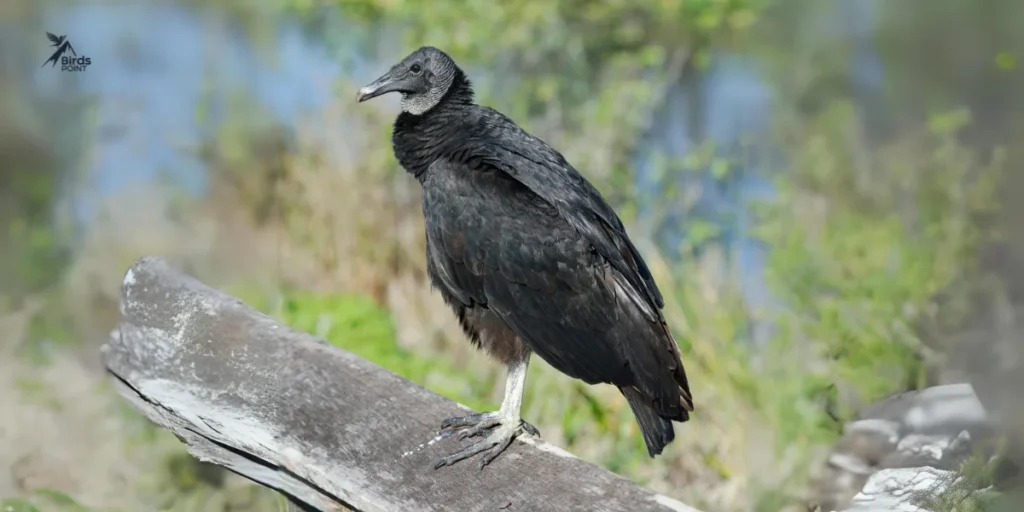
Appearance
The Black Vulture has a distinctive appearance with its all-black plumage and a bare, wrinkled gray-black head and neck. Its broad, short tail and relatively short wings are noticeable when soaring, where the white patches on the underside of the wingtips become visible. Unlike other vultures, they have a short, stocky build and a squared-off tail. Their strong beak is designed for tearing flesh, making them efficient scavengers.
Migration Habits
Black Vultures are largely non-migratory, especially in warmer regions like Florida, where they are year-round residents. However, they may move short distances in response to changes in food availability or severe weather conditions.
Nesting
Black Vultures do not build traditional nests. Instead, they lay their eggs directly on the ground in protected areas such as caves, hollow trees, or abandoned buildings. They typically lay 1-3 eggs, which are incubated by both parents. The chicks are fed through regurgitation and remain in the nest for about two to three months before fledging.
Feeding Behavior
Black Vultures primarily feed on carrion, using their keen eyesight to locate dead animals. Unlike Turkey Vultures, which rely heavily on their sense of smell, Black Vultures follow other scavengers to carcasses. They are also known to hunt small animals like newborn livestock or injured wildlife, though this is less common. They often feed in groups and can be aggressive toward other scavengers when competing for food.
Behavior and Personality
Black Vultures are social birds, often roosting and feeding in large groups. They are known for their strong family bonds and tend to stick with their group. In flight, they can be seen soaring on thermals with their wings held flat and flapping more frequently than their relatives, the Turkey Vultures. Their flight is somewhat less graceful due to their shorter wings. Despite their scavenging habits, they play a crucial role in the ecosystem by cleaning up dead animals, which helps prevent the spread of disease.
Habitat
Black Vultures thrive in a variety of habitats, including forests, open fields, wetlands, and even urban areas. They are highly adaptable and can often be found near roadsides, landfills, and farms where carrion is abundant. In Florida, they are common in both rural and suburban environments, often seen roosting in large groups on buildings or trees.
| Category | Details |
|---|---|
| Status | Least Concern |
| State Status | Common year-round in Florida |
| Wingspan | 137-150 cm (54-59 in) |
| Sound | Hissing and grunting sounds; generally silent |
| Appearance | All-black plumage, gray-black bare head, white patches on wingtips, short square tail |
Turkey Vulture (Cathartes aura)
Size: 64-81 cm (25-32 in)
Weight: 850-2000 g (1.9-4.4 lbs)
Lifespan: 10-16 years, with some individuals living up to 20 years
Diet: Primarily carrion
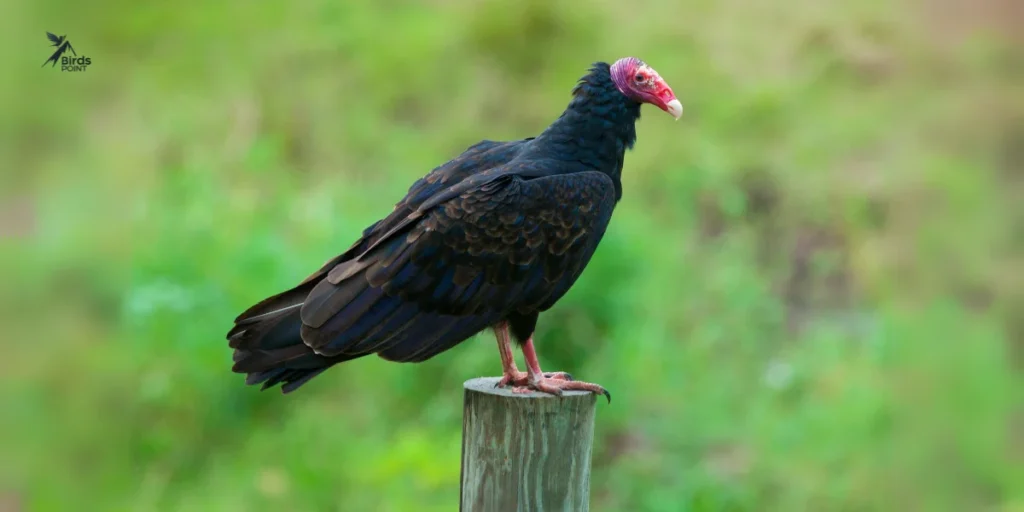
Appearance
The Turkey Vulture is easily recognized by its featherless red head, resembling that of a wild turkey, and its dark brown to black plumage. The wings are long and broad, with a noticeable two-tone color: black leading edges and silver-gray underwings. In flight, Turkey Vultures hold their wings in a shallow V-shape and appear to wobble while soaring. Juveniles have darker, grayish heads that gradually turn red as they mature.
Migration Habits
Turkey Vultures are partially migratory. In southern regions like Florida, they are present year-round. In northern areas, they migrate south during the winter to warmer climates in Central and South America. They often migrate in large groups, taking advantage of thermals to conserve energy during long flights.
Nesting
Turkey Vultures do not build nests in the traditional sense. Instead, they lay their eggs directly on the ground in hidden, protected areas such as caves, hollow logs, or dense thickets. The female typically lays 1-3 eggs, and both parents take part in incubating the eggs and feeding the young. The chicks are fed regurgitated food and remain in the nest for around 10-11 weeks.
Feeding Behavior
Turkey Vultures are primarily scavengers, feeding on carrion. They have an extraordinary sense of smell, which allows them to detect dead animals from great distances, even when the carcass is hidden under vegetation. Unlike Black Vultures, which rely on sight and follow others to carrion, Turkey Vultures can locate food independently. They prefer freshly dead animals but will feed on older carcasses if necessary.
Behavior and Personality
Turkey Vultures are known for their graceful soaring flight, often seen gliding effortlessly on thermals with minimal wing flapping. They are social birds, frequently roosting in large groups in trees or on structures. Though primarily scavengers, they play an important ecological role by cleaning up dead animals and preventing the spread of disease. Despite their intimidating appearance, they are generally non-aggressive toward humans and other animals.
Habitat
Turkey Vultures are highly adaptable and can be found in a wide variety of habitats, including forests, open fields, deserts, wetlands, and urban areas. They are commonly seen near roadsides, fields, and landfills where carrion is plentiful. In Florida, they are widespread across the state, often seen soaring overhead or roosting in groups.
| Category | Details |
|---|---|
| Status | Least Concern |
| State Status | Common year-round in Florida |
| Wingspan | 170-178 cm (67-70 in) |
| Sound | Hissing and low grunts; generally silent |
| Appearance | Dark brown to black plumage, red featherless head, silver-gray underwings, long wings held in a V-shape in flight |
5. Owls: Nocturnal Predators
Owls are elusive, nocturnal hunters that play a significant role in controlling populations of rodents and other small animals. Florida’s diverse owl species each bring their own unique hunting strategies to the ecosystem.
Great Horned Owl (Bubo virginianus)
Size: 46-63 cm (18.1-24.8 in)
Weight: 910-2500 g (2-5.5 lbs)
Lifespan: 10-15 years in the wild, up to 28 years in captivity
Diet: Small to medium-sized mammals, birds, reptiles, and insects

Appearance
The Great Horned Owl is one of the most powerful and easily recognized owls in North America. It has large ear tufts, or “horns,” which give it its name, though these are actually feathers. Its plumage is mottled brown and gray with a white throat and striking yellow eyes. The owl’s large body and broad wings give it a formidable presence. Juveniles are fluffier with paler plumage until they mature.
Migration Habits
Great Horned Owls are non-migratory and remain in their established territories year-round. They are highly adaptable and can thrive in a wide variety of climates and habitats. During the winter, they may shift slightly within their range in response to food availability, but they do not undertake long migrations.
Nesting
These owls are early nesters, often taking over nests built by other large birds, such as hawks or crows. They nest in a variety of locations, including tree cavities, cliff edges, and even man-made structures. Females typically lay 1-4 eggs, and both parents take part in caring for the young, though the female incubates the eggs while the male provides food. The chicks stay in the nest for about 6-9 weeks before they fledge.
Feeding Behavior
Great Horned Owls are versatile and formidable hunters. Their diet includes small mammals such as rabbits, squirrels, and mice, as well as birds, including other owls and hawks. They are also known to take reptiles, amphibians, and even insects when necessary. Great Horned Owls hunt primarily at night, using their silent flight and exceptional night vision to locate prey. Their powerful talons can exert immense pressure, allowing them to capture and kill larger prey.
Behavior and Personality
Great Horned Owls are known for their deep, booming hoots, which are often heard in forests, deserts, and suburban areas alike. They are highly territorial and will aggressively defend their nests from other predators, including humans, if threatened. Though they are solitary birds, they form strong pair bonds during the breeding season. Their calm and composed demeanor gives them a commanding presence in the wild.
Habitat
Great Horned Owls are one of the most adaptable owl species and can live in a wide variety of habitats, including forests, deserts, wetlands, grasslands, and even urban areas. They prefer habitats with open spaces for hunting and tall trees or cliffs for nesting. In Florida, they are common in both rural and suburban settings, often seen or heard at dusk and dawn.
| Category | Details |
|---|---|
| Status | Least Concern |
| State Status | Common year-round in Florida |
| Wingspan | 101-145 cm (40-57 in) |
| Sound | Deep, resonant hoots: “hoo-hoo-hoooooo” |
| Appearance | Large ear tufts, mottled brown and gray plumage, yellow eyes, white throat patch |
Barred Owl (Strix varia)
Size: 43-50 cm (16.9-19.7 in)
Weight: 470-1050 g (1-2.3 lbs)
Lifespan: 10-15 years in the wild, up to 23 years in captivity
Diet: Small mammals, birds, amphibians, reptiles, and invertebrates
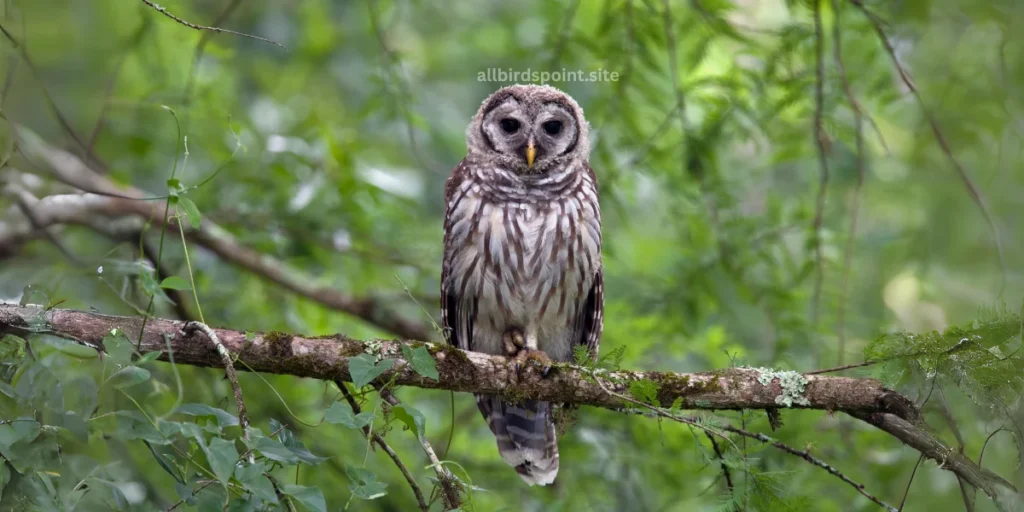
Appearance
The Barred Owl is known for its round face, large dark eyes, and lack of ear tufts. Its plumage is mostly brown and white, with distinctive horizontal barring on its chest and vertical streaks on its belly, giving it its name. Its face is pale with concentric rings around the eyes, and its wings and back are a mix of brown and white patterns. Juveniles are fluffier and paler but quickly develop the characteristic barred markings as they mature.
Migration Habits
Barred Owls are non-migratory and remain in their territories year-round. They are highly sedentary, staying close to their nesting sites throughout the year. However, juveniles may disperse over shorter distances after fledging to establish their own territories.
Nesting
These owls prefer to nest in natural tree cavities or abandoned nests of other large birds, such as hawks or crows. They are also known to nest in artificial nest boxes. Females lay 2-4 eggs, which are incubated by the female while the male provides food. After about 28-33 days, the eggs hatch, and the chicks remain in the nest for around 4-6 weeks before fledging.
Feeding Behavior
Barred Owls are opportunistic hunters, feeding on a wide variety of prey. Their diet includes small mammals such as mice, voles, and squirrels, as well as birds, amphibians, reptiles, and insects. They hunt primarily at night but can also be active during the day, especially at dawn and dusk. Using their excellent hearing and night vision, they locate prey and silently swoop down from a perch to capture it with their sharp talons.
Behavior and Personality
Barred Owls are known for their distinctive call, which sounds like “Who cooks for you? Who cooks for you all?” Their vocalizations are one of the most recognizable sounds in forests where they live. These owls are territorial and will defend their nesting sites, though they are generally less aggressive than Great Horned Owls. Barred Owls are relatively tame and curious, often allowing humans to approach them closely. They are most active at night but can occasionally be seen during the day.
Habitat
Barred Owls prefer dense, mature forests, especially near bodies of water such as swamps, rivers, and wetlands. They are highly adaptable and can also be found in suburban areas with sufficient tree cover. In Florida, they are common in forested areas, particularly near wetlands and swamps, where they thrive.
| Category | Details |
|---|---|
| Status | Least Concern |
| State Status | Common year-round in Florida |
| Wingspan | 99-110 cm (39-43 in) |
| Sound | Distinctive call: “Who cooks for you? Who cooks for you all?” |
| Appearance | Brown and white plumage with horizontal barring on chest and vertical streaks on belly, large dark eyes |
Eastern Screech-Owl (Megascops asio)
Size: 16-25 cm (6.3-9.8 in)
Weight: 121-244 g (4.3-8.6 oz)
Lifespan: 8-10 years in the wild, up to 14 years in captivity
Diet: Small mammals, birds, insects, and reptiles
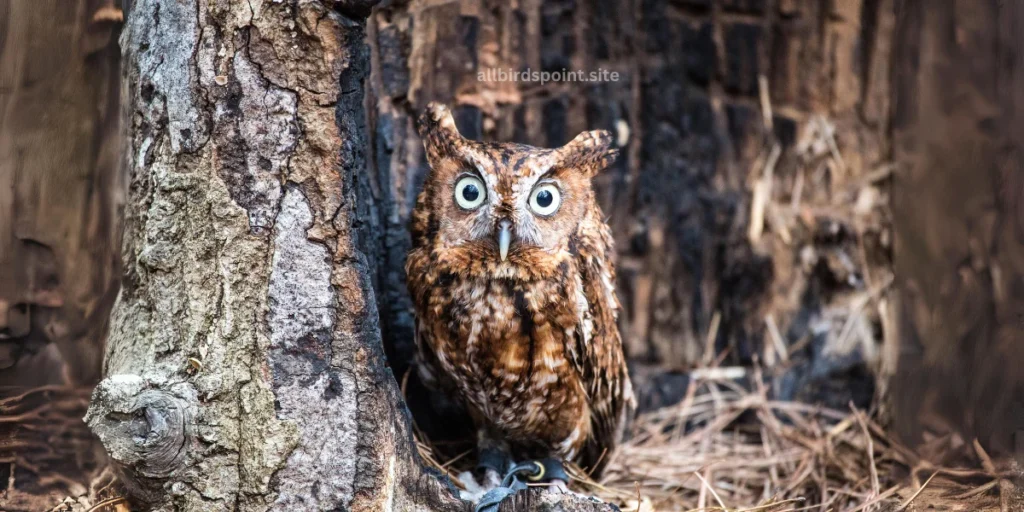
Appearance
The Eastern Screech-Owl is a small owl with ear tufts and can appear in two distinct color morphs: gray or reddish-brown (rufous). Both morphs are heavily patterned with streaks and spots, helping them blend into tree bark. They have yellow eyes and a stocky build with a short tail, making them look larger than they are. Their camouflaged appearance allows them to remain hidden during the day, making them difficult to spot.
Migration Habits
Eastern Screech-Owls are non-migratory and stay within their home range year-round. They are very adaptable to different habitats and remain close to their nesting or roosting sites throughout the year.
Nesting
These owls nest in tree cavities, often using old woodpecker holes or natural cavities in trees. They will also use nest boxes if available. Females lay 2-6 eggs, which are incubated by the female for about 26 days. Both parents help care for the young, which fledge after 4-5 weeks. Eastern Screech-Owls are protective of their nests and will defend them aggressively from predators.
Feeding Behavior
Eastern Screech-Owls are opportunistic hunters and have a varied diet. They feed on small mammals, such as mice and voles, as well as small birds, insects, and even reptiles and amphibians. These owls hunt primarily at night, using their excellent hearing and sight to locate prey. They usually hunt from a perch, silently swooping down to catch prey in their sharp talons.
Behavior and Personality
Eastern Screech-Owls are known for their distinctive trilling or whinnying calls, which are often heard at night. Despite their name, they do not actually “screech” frequently. These owls are nocturnal and very well camouflaged, making them difficult to spot during the day. They are solitary except during the breeding season, and although small, they are bold and will defend their nests against larger predators.
Habitat
Eastern Screech-Owls are highly adaptable and can be found in a wide variety of habitats, including forests, woodlands, swamps, orchards, and suburban areas. They are particularly common in areas with plenty of trees for nesting. In Florida, they are often seen in both rural and urban environments, nesting in cavities and hunting for insects and small animals at night.
| Category | Details |
|---|---|
| Status | Least Concern |
| State Status | Common year-round in Florida |
| Wingspan | 46-61 cm (18-24 in) |
| Sound | Trills or whinnies, often heard at night |
| Appearance | Small with ear tufts, gray or reddish-brown color morphs, heavily patterned to blend in with tree bark, yellow eyes |
Burrowing Owl (Athene cunicularia)
Size: 19-25 cm (7.5-9.8 in)
Weight: 150 g (5.3 oz)
Lifespan: 6-8 years in the wild, up to 10 years in captivity
Diet: Insects, small mammals, reptiles, amphibians, and birds

Appearance
The Burrowing Owl is a small, long-legged owl with a round head and no ear tufts. It has sandy brown plumage with white spots on its back and wings, and a white “eyebrow” over its large yellow eyes. Its underparts are paler with brown barring. Burrowing Owls are known for their expressive faces and relatively long legs, which help them move quickly on the ground.
Migration Habits
In Florida, Burrowing Owls are non-migratory and stay within their territories year-round. In northern regions of their range, some populations migrate south during the winter to warmer climates. However, Florida’s population is resident and adapts to local conditions without significant seasonal movement.
Nesting
Burrowing Owls are unique among owls because they live and nest in burrows, often repurposing the abandoned burrows of mammals like prairie dogs, ground squirrels, or gophers. They may also dig their own burrows. They typically lay 6-12 eggs, which are incubated by the female for about 28-30 days. Both parents take part in caring for the chicks, which remain in the burrow for several weeks before emerging. Burrowing Owls are very social and often live in small colonies.
Feeding Behavior
Burrowing Owls are opportunistic feeders with a varied diet. They primarily hunt insects, such as beetles, grasshoppers, and crickets, but they also catch small mammals, reptiles, amphibians, and birds. Unlike most owls, Burrowing Owls are often active during the day, especially in the early morning and late afternoon, though they do most of their hunting at night. They hunt by perching near the ground and swooping down to catch prey or by running after insects.
Behavior and Personality
Burrowing Owls are known for their curious and bold personalities. They often bob their heads up and down when they feel threatened or curious and will stand guard near their burrows during the day. They are social birds and can live in colonies, often working together to protect their young from predators. Their calls include soft coos and short chattering sounds, and they can be quite vocal, especially during the breeding season.
Habitat
Burrowing Owls prefer open habitats with low vegetation, such as grasslands, prairies, deserts, and agricultural fields. In Florida, they are often found in sandy soils, vacant lots, and even suburban areas. They require open areas for hunting and burrowing and are commonly seen standing near the entrance of their burrows during daylight hours.
| Category | Details |
|---|---|
| Status | Least Concern (in general), but threatened in some states |
| State Status | Common year-round in Florida, especially in southern and central regions |
| Wingspan | 55 cm (21.6 in) |
| Sound | Soft cooing, chattering, and alarm calls |
| Appearance | Small, brown with white spots, long legs, yellow eyes, white “eyebrows” |
Barn Owl (Tyto alba)
Size: 32-40 cm (12.6-15.8 in)
Weight: 400-700 g (14.1-24.7 oz)
Lifespan: 4-8 years in the wild, up to 15 years in captivity
Diet: Small mammals, particularly rodents, but also birds, reptiles, and insects
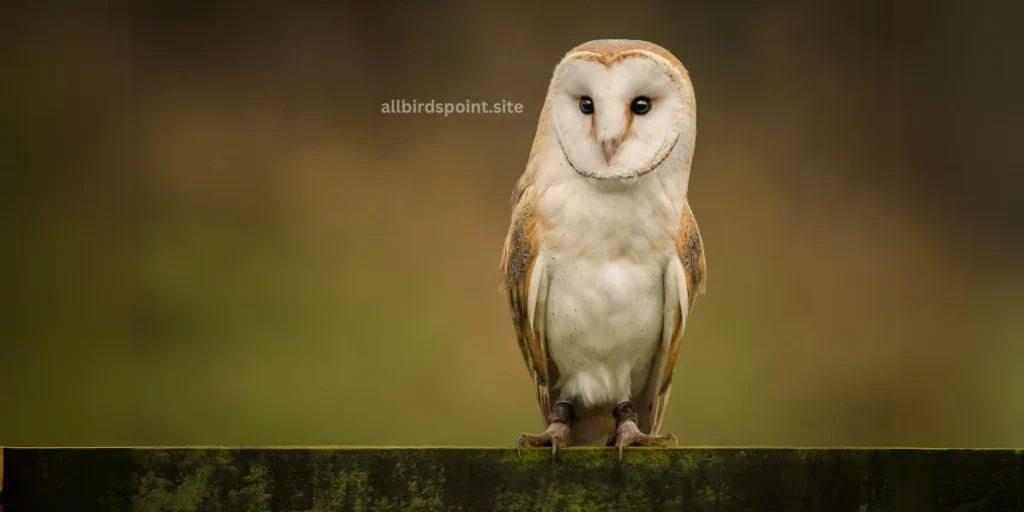
Appearance
The Barn Owl is known for its distinctive heart-shaped, pale face and ghostly white underparts. Its upperparts are golden-brown with gray speckles, while its underparts range from pure white to buff. Its dark, soulful eyes stand out against its white face. Barn Owls have long, rounded wings and a short tail, giving them a graceful, silent flight. Unlike many other owls, they do not have ear tufts.
Migration Habits
Barn Owls are non-migratory and tend to stay in their home territories year-round. However, in colder climates, some may move short distances in search of better food sources or to avoid harsh winter conditions. In warmer areas like Florida, they are permanent residents.
Nesting
Barn Owls nest in a variety of locations, including barns, old buildings, tree cavities, and even cliffs. They do not build traditional nests, instead laying their eggs directly on existing debris in their chosen nesting sites. Females typically lay 4-7 eggs, which are incubated for about 30-34 days. Both parents help raise the chicks, feeding them regurgitated food until they are ready to fledge after about 7-10 weeks.
Feeding Behavior
Barn Owls are highly effective hunters, with a diet primarily consisting of small mammals, especially rodents such as mice, voles, and rats. They hunt mostly at night, using their exceptional hearing and silent flight to locate prey. Their heart-shaped face acts like a satellite dish, funneling sound to their ears, allowing them to detect even the slightest movements of their prey in total darkness. Once they spot or hear their target, they swoop down silently and capture it with their sharp talons.
Behavior and Personality
Barn Owls are quiet and secretive birds, often active only at night. Despite their eerie appearance, they are gentle and rarely aggressive toward humans. They are known for their silent flight, which is due to specialized feathers that reduce turbulence and noise. Their calls are quite different from other owls; instead of hooting, they emit a loud, eerie screech or hiss, which can be startling when heard at night. Barn Owls play a crucial role in controlling rodent populations, making them valuable to farmers and rural communities.
Habitat
Barn Owls are found in open habitats such as grasslands, farmlands, marshes, and deserts. They prefer areas with plenty of open ground for hunting, but they require sheltered places to roost and nest, such as barns, abandoned buildings, or large tree cavities. In Florida, they are often found in rural areas, agricultural fields, and wetlands, where they have easy access to prey and suitable nesting sites.
| Category | Details |
|---|---|
| Status | Least Concern |
| State Status | Common year-round in Florida |
| Wingspan | 100-125 cm (39.4-49.2 in) |
| Sound | Harsh screech, hissing sounds; does not hoot |
| Appearance | Heart-shaped face, white underparts, golden-brown upperparts, dark eyes, long rounded wings |
Short-eared Owl (Asio flammeus)
Size: 34-43 cm (13.4-16.9 in)
Weight: 206-475 g (7.3-16.8 oz)
Lifespan: 4-12 years
Diet: Primarily small mammals, particularly voles, but also birds, insects, and other small animals
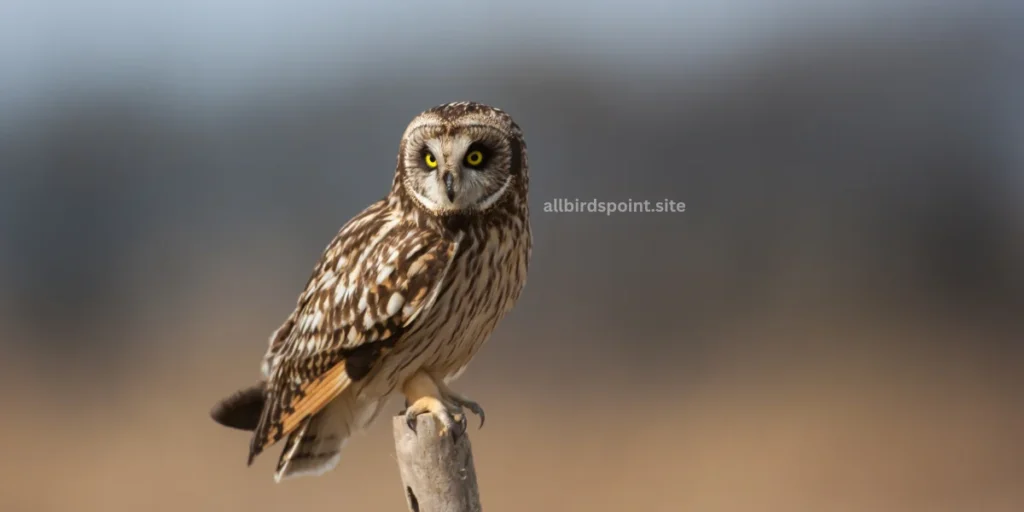
Appearance
The Short-eared Owl is a medium-sized owl with mottled brown and buff plumage, giving it excellent camouflage in its grassland and marshland habitats. Its name comes from the small, often invisible ear tufts that are rarely seen. It has large yellow eyes framed by black rings and a round facial disk that helps direct sound to its ears. Its wings are long and broad, and its flight is buoyant and moth-like, often seen gliding low over open fields.
Migration Habits
Short-eared Owls are partially migratory. In northern regions, they migrate south in winter, moving to warmer areas like Florida. These owls are considered nomadic and follow prey populations, often migrating irregularly depending on the availability of food. In Florida, they are primarily winter visitors.
Nesting
Unlike many other owls, Short-eared Owls nest on the ground, typically in open areas like grasslands, prairies, and marshes. The female creates a simple nest by scraping a shallow depression in the ground and lining it with grass and feathers. She lays 4-7 eggs, which are incubated for about 24-29 days. The young owlets are precocial, meaning they are relatively developed when they hatch and leave the nest shortly after fledging.
Feeding Behavior
Short-eared Owls are crepuscular, meaning they are most active during the dawn and dusk, but they may also hunt during the day, especially in winter. They primarily hunt small mammals, particularly voles, which they locate by flying low over fields and marshes. Their flight is characterized by slow, deliberate wing beats and gliding as they scan the ground for movement. Once prey is spotted, they swoop down to capture it with their sharp talons.
Behavior and Personality
Short-eared Owls are relatively social compared to other owls and are often seen hunting in loose groups when prey is abundant. They are known for their distinctive flight pattern, which is buoyant and erratic, almost moth-like. When threatened, they rely on their camouflage to remain unseen, and if disturbed, they will fly away low to the ground. Their vocalizations are typically soft barks, hoots, and whistles, though they are not particularly vocal except during the breeding season.
Habitat
Short-eared Owls prefer open habitats such as grasslands, marshes, tundra, and prairies. They are often found in areas with dense ground cover that supports their prey species. In Florida, they are primarily seen in open fields and marshes during the winter months. Their ground-nesting habits require large, undisturbed areas, making habitat conservation important for their survival.
| Category | Details |
|---|---|
| Status | Least Concern (globally), but declining in some areas due to habitat loss |
| State Status | Winter visitor in Florida, found in open habitats |
| Wingspan | 85-103 cm (33.5-40.5 in) |
| Sound | Soft barks, hoots, and whistles; generally quiet outside the breeding season |
| Appearance | Mottled brown and buff plumage, small ear tufts, yellow eyes with black “eyeliner,” long wings |
Northern Saw-whet Owl (Aegolius acadicus)
Size: 18-21 cm (7.1-8.3 in)
Weight: 65-151 g (2.3-5.3 oz)
Lifespan: 7-10 years
Diet: Primarily small mammals, particularly mice and voles, but also small birds and insects
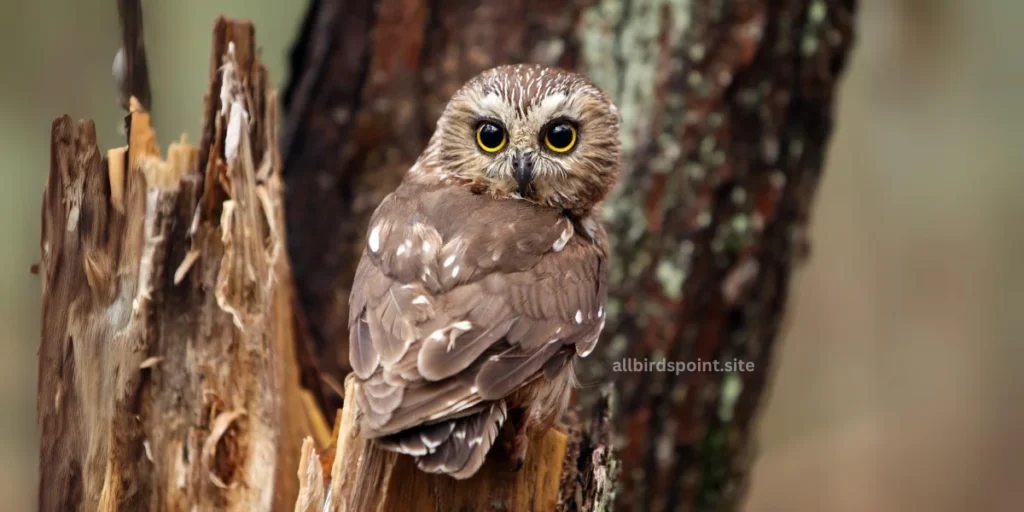
Appearance
The Northern Saw-whet Owl is a small, round owl with a large head and no visible ear tufts. It has brown upperparts with white spots and pale underparts streaked with brown. Its large yellow eyes are framed by a white facial disk, giving it a wide-eyed and somewhat endearing appearance. The owl’s name comes from one of its calls, which resembles the sound of a saw being sharpened.
Migration Habits
Northern Saw-whet Owls are partial migrants. They are more likely to migrate in the northern parts of their range, moving south during winter to avoid colder temperatures. They typically migrate at night and are seldom seen during migration. Some may travel to southern parts of the U.S., including Florida, as winter visitors, though they are rare in the state.
Nesting
These owls nest in tree cavities, often using old woodpecker holes. They may also use nest boxes if available. Females lay 4-7 eggs, which she incubates for about 26-29 days. During this time, the male provides food for the female and the young. Once hatched, the owlets grow rapidly and leave the nest after about 4-5 weeks. The young may continue to depend on their parents for food for a short time after fledging.
Feeding Behavior
Northern Saw-whet Owls are nocturnal hunters, relying on their excellent hearing and night vision to catch prey. They feed primarily on small mammals such as mice and voles, but they will also eat small birds and large insects when available. They typically hunt by perching on low branches or shrubs, listening for movement below. Once they detect prey, they silently swoop down to grab it with their sharp talons.
Behavior and Personality
These owls are shy, secretive, and difficult to spot due to their small size and nocturnal habits. During the day, they roost in dense foliage, relying on their camouflaged plumage to blend into their surroundings. Despite their small size, they are fierce predators. Their call is a repetitive, high-pitched “too-too-too” sound, which is often compared to the sound of a saw being sharpened. They are most vocal during the breeding season.
Habitat
Northern Saw-whet Owls prefer dense forests, particularly coniferous or mixed woodlands, where they can find plenty of cover for roosting and hunting. In winter, they may migrate to more open areas, but they generally stick to wooded habitats. In Florida, they are rare and are typically seen only during winter migrations in northern parts of the state.
| Category | Details |
|---|---|
| Status | Least Concern |
| State Status | Rare winter visitor in northern Florida |
| Wingspan | 42-48 cm (16.5-18.9 in) |
| Sound | Repetitive “too-too-too” call, like a saw being sharpened |
| Appearance | Small, round body with brown and white streaked plumage, large yellow eyes, no ear tufts |
6. Falcons: Speed and Agility in the Sky
Falcons are known for their incredible speed, precision, and aerial hunting abilities. These sleek, agile birds are masters of the skies, using rapid dives and high-speed chases to capture prey.
American Kestrel (Falco sparverius)
Size: 22-31 cm (8.7-12.2 in)
Weight: 80-165 g (2.8-5.8 oz)
Lifespan: 5-10 years in the wild, up to 15 years in captivity
Diet: Insects, small mammals, birds, and reptiles
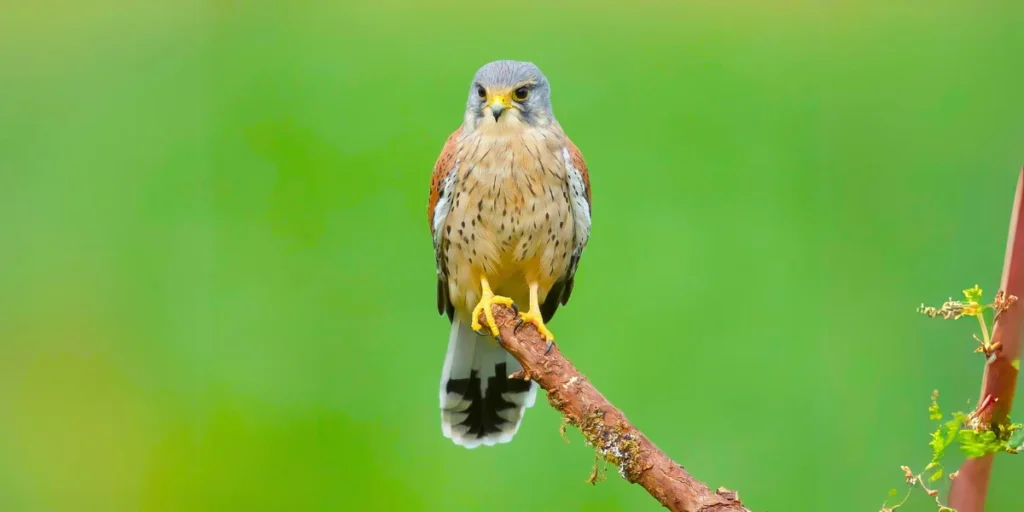
Appearance
The American Kestrel is the smallest falcon in North America and one of the most colorful raptors. Males have striking blue-gray wings, a rusty-red back, and a tail with a black band at the tip. Females are slightly larger and have more uniformly reddish-brown wings and backs with dark barring. Both sexes have black vertical “sideburn” markings on their faces, giving them a distinctive, fierce look. Their long, pointed wings and tail are adapted for fast, agile flight.
Migration Habits
American Kestrels are partially migratory, depending on their location. In northern regions, they migrate south for the winter, while kestrels in warmer climates, such as Florida, are typically year-round residents. During migration, they can travel long distances, sometimes as far as Central or South America.
Nesting
Kestrels nest in cavities, such as abandoned woodpecker holes, tree hollows, or nest boxes. They do not build traditional nests, instead laying their eggs on whatever material is present in the cavity. Females lay 4-5 eggs, which they incubate for about 30 days. Both parents help feed the young, which fledge at around 28-31 days old. They are highly adaptable and can nest in a variety of environments, including urban areas where suitable nest sites are available.
Feeding Behavior
American Kestrels are versatile hunters, feeding primarily on insects like grasshoppers, beetles, and crickets during the summer, and small mammals, birds, and reptiles in the winter. They often hunt by hovering in the air or perching on a high vantage point, scanning the ground for prey. Once prey is spotted, they dive quickly to capture it with their sharp talons. Their small size allows them to hunt efficiently in open fields, farmlands, and grassy areas.
Behavior and Personality
American Kestrels are active, energetic birds that are known for their hovering flight and swift hunting dives. They are highly territorial, especially during the breeding season, and will aggressively defend their nesting sites. Kestrels are also known for their distinct vocalizations, which include a high-pitched “klee-klee-klee” call. They are often seen perched on telephone wires or fence posts, scanning their surroundings for food. Despite their small size, they are bold and agile hunters.
Habitat
American Kestrels prefer open habitats, such as grasslands, farmlands, deserts, and suburban areas, where they can easily spot prey from perches or while hovering. They thrive in areas with scattered trees or structures that provide nesting sites. In Florida, they are commonly found in open fields, agricultural lands, and urban environments, where they can nest in buildings or nest boxes.
| Category | Details |
|---|---|
| Status | Least Concern |
| State Status | Common year-round in Florida, more migratory in northern areas |
| Wingspan | 51-61 cm (20-24 in) |
| Sound | High-pitched “klee-klee-klee” calls |
| Appearance | Males: blue-gray wings, rusty-red back; Females: reddish-brown with dark barring; both with black facial markings |
Peregrine Falcon (Falco peregrinus)
Size: 36-49 cm (14.2-19.3 in)
Weight: 530-1600 g (18.7-56.4 oz)
Lifespan: 12-20 years in the wild, up to 25 years in captivity
Diet: Primarily birds, especially pigeons and small to medium-sized birds
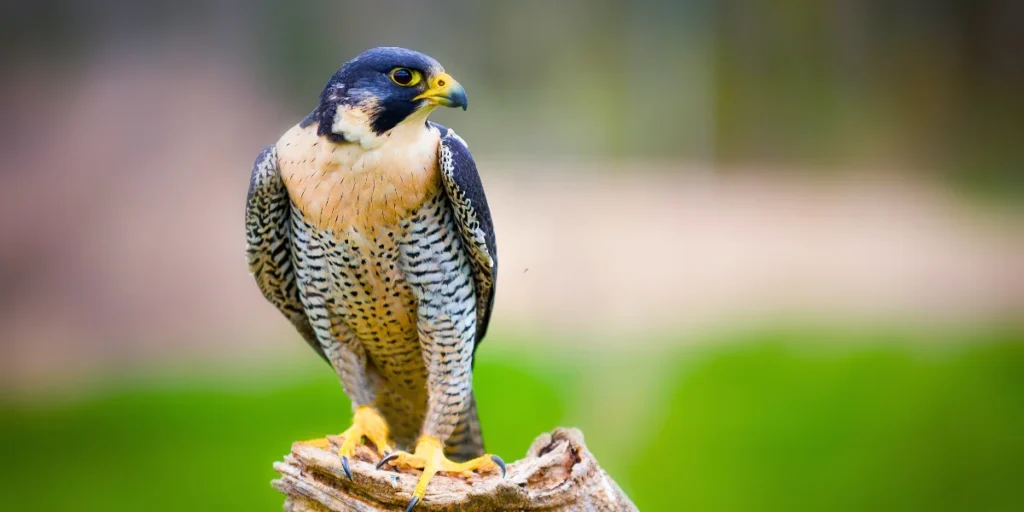
Appearance
The Peregrine Falcon is a sleek, powerful bird of prey known for its incredible speed. Adults have a bluish-gray back, dark wingtips, and a light-colored underside with fine horizontal barring. Their heads are dark with a prominent black “moustache” marking, contrasting with their pale faces. Juveniles are brown with streaked underparts. Peregrines have long, pointed wings and a long tail, making them agile fliers.
Migration Habits
Peregrine Falcons are partially migratory, depending on their location. In northern regions, they migrate south during the winter to escape the cold, often traveling as far as South America. Falcons in warmer climates, such as Florida, are typically year-round residents. During migration, they are known to cover great distances, sometimes flying thousands of miles.
Nesting
Peregrine Falcons nest on high ledges, cliffs, and sometimes tall urban buildings. They do not build traditional nests, but instead lay their eggs in a shallow scrape on a rocky ledge or other suitable spot. Females typically lay 3-4 eggs, which are incubated for about 29-32 days. Both parents share the responsibility of feeding the young, which fledge about 35-42 days after hatching. In urban environments, they have adapted to nesting on skyscrapers, bridges, and other tall structures.
Feeding Behavior
Peregrine Falcons are exceptional hunters, known for their high-speed dives, called “stoops,” where they can reach speeds of up to 240 miles per hour, making them the fastest birds on the planet. They primarily hunt birds, catching them mid-air with incredible precision. Pigeons, doves, and small to medium-sized birds make up the majority of their diet, but they will also catch ducks, shorebirds, and occasionally bats. Peregrines spot their prey from a high perch or while soaring, then dive at lightning speed to capture their target with their sharp talons.
Behavior and Personality
Peregrine Falcons are known for their incredible agility and speed in flight, especially during hunting. They are highly territorial, especially during the breeding season, and will aggressively defend their nest sites from intruders. Their vocalizations include loud “kak-kak-kak” calls, especially during interactions with other falcons or threats. Peregrines have made a remarkable recovery after near-extinction in the 20th century due to pesticide use and are now thriving in both wild and urban environments.
Habitat
Peregrine Falcons prefer open habitats, including coastal cliffs, mountains, and large open fields where they can hunt. They have also adapted well to urban environments, where tall buildings mimic the cliffs they traditionally nest on. In Florida, Peregrine Falcons are commonly found near the coast, wetlands, and urban areas. They are particularly drawn to cities with large populations of pigeons, which make up a significant portion of their diet.
| Category | Details |
|---|---|
| Status | Least Concern (formerly endangered) |
| State Status | Common winter visitor in Florida, some resident populations |
| Wingspan | 100-110 cm (39.4-43.3 in) |
| Sound | Loud “kak-kak-kak” calls, especially near the nest |
| Appearance | Bluish-gray back, light underside with horizontal barring, black “moustache” markings on face |
Merlin (Falco columbarius)
Size: 24-30 cm (9.4-11.8 in)
Weight: 160-240 g (5.6-8.5 oz)
Lifespan: 5-10 years in the wild
Diet: Primarily small birds, but also insects and small mammals
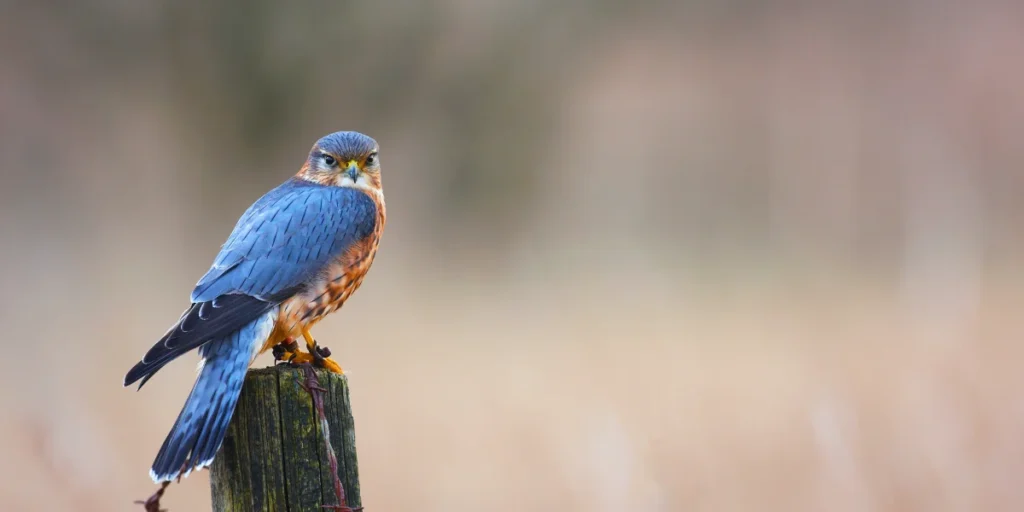
Appearance
The Merlin is a small, compact falcon with a powerful build and rapid flight. Males have a slate-blue back with dark streaks on the breast, while females and juveniles are brown with streaked underparts. Both sexes have a banded tail and dark wingtips. Merlins are stocky compared to other falcons, with short, pointed wings and a medium-length tail that gives them agility during high-speed chases.
Migration Habits
Merlins are migratory birds, with populations in northern regions flying south during the winter months. They winter as far south as Central and South America, including Florida, where they are regular visitors. In their breeding range, they are found in northern forests, but they move to more open areas like grasslands and coastal regions during migration and winter.
Nesting
Merlins do not build their own nests; instead, they often take over the abandoned nests of other birds, such as crows or hawks, in tall trees. In more remote areas, they may nest on cliffs or ground scrapes. Females lay 3-6 eggs, and both parents help incubate and feed the young. The chicks fledge after about 30 days and remain dependent on their parents for a few more weeks.
Feeding Behavior
Merlins are aggressive and skilled hunters, known for their speed and agility in the air. They primarily prey on small birds, such as sparrows and finches, which they catch in mid-air during fast chases. They also hunt large insects and occasionally small mammals. Merlins are often seen hunting in pairs or groups, especially during migration, where they may cooperate to flush out birds from dense cover. Their fast, powerful flight allows them to quickly overtake and capture prey.
Behavior and Personality
Merlins are bold and active falcons, known for their aggressive hunting style. They are relentless hunters, capable of pursuing prey over long distances with speed and precision. Unlike larger falcons, they rely on fast chases rather than diving from high altitudes. They are territorial during the breeding season and will defend their nests aggressively. Their calls include sharp, chattering sounds, especially during the breeding season or when threatened.
Habitat
During the breeding season, Merlins are typically found in northern coniferous forests or open woodlands. During migration and winter, they prefer open areas such as grasslands, coastal regions, and agricultural fields, where small birds and insects are plentiful. In Florida, they are often seen near open areas, along the coast, and in urban parks where they hunt for birds and insects.
| Category | Details |
|---|---|
| Status | Least Concern |
| State Status | Common winter visitor in Florida |
| Wingspan | 53-68 cm (20.9-26.8 in) |
| Sound | Sharp, rapid chattering calls |
| Appearance | Males: slate-blue back with streaked underparts; Females/juveniles: brown with streaks, banded tail, dark wingtips |
Crested Caracara (Caracara plancus)
Size: 49-58 cm (19.3-22.8 in)
Weight: 1050-1300 g (37-45.9 oz)
Lifespan: 10-20 years in the wild
Diet: Carrion, small mammals, birds, reptiles, insects
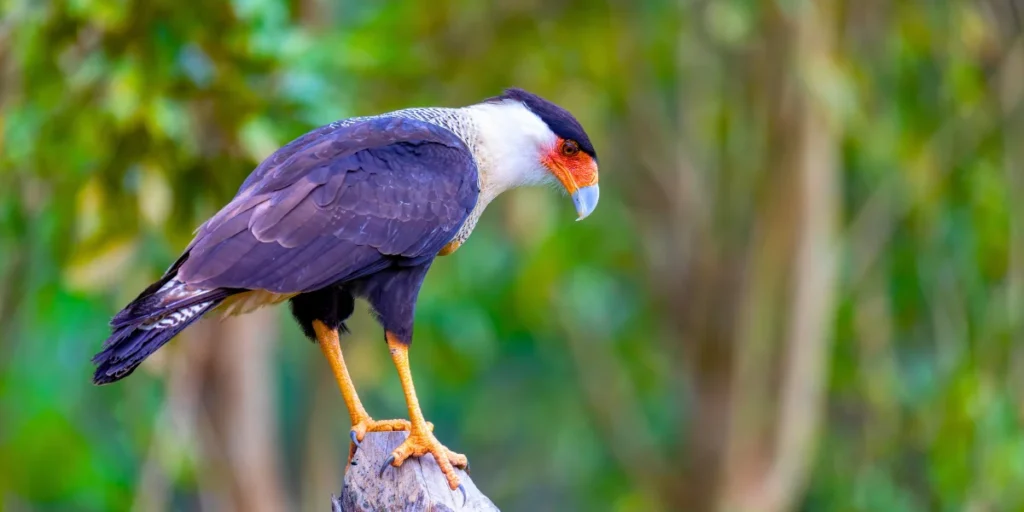
Appearance
The Crested Caracara is a striking bird with a bold black cap and a bright orange or yellowish facial skin that contrasts sharply with its black and white plumage. Its upperparts are dark brown to black, while its underparts are white with dark barring on the chest and belly. The wings and tail are black with bold white markings. Its long legs give it an upright posture, and its hooked beak is designed for tearing into carrion. Unlike many raptors, the Crested Caracara is more terrestrial and spends significant time walking on the ground.
Migration Habits
Crested Caracaras are generally non-migratory, remaining in their home territories year-round. However, some individuals may wander over short distances in search of food, especially in areas where food availability fluctuates seasonally. In Florida, they are year-round residents and are most commonly found in central and southern parts of the state.
Nesting
Crested Caracaras build large, bulky nests made of sticks, usually in tall trees, but they can also nest on large cacti or even on the ground in areas with little vegetation. Females lay 2-3 eggs, which are incubated by both parents for about 28-32 days. Both parents also take part in feeding and protecting the young, which fledge after about 8-9 weeks. They are attentive parents and often reuse nests for multiple seasons.
Feeding Behavior
Crested Caracaras are opportunistic feeders, with a diet that includes carrion, small mammals, reptiles, birds, and insects. They are often seen feeding on roadkill, scavenging alongside vultures. Unlike vultures, Caracaras are also capable hunters and will catch live prey when the opportunity arises. They are known for their intelligence and resourcefulness, often foraging on the ground for insects or small animals. They can also steal food from other birds.
Behavior and Personality
Crested Caracaras are social and often seen in pairs or small groups. They are highly adaptable and spend much of their time on the ground, walking or running in search of food. Their flight is less graceful than other raptors, but they are strong fliers capable of covering large distances in search of food. They are vocal birds and communicate with a series of guttural sounds. Despite their scavenging habits, they are bold and will defend their territory aggressively from other predators and scavengers.
Habitat
Crested Caracaras prefer open, semi-open habitats such as grasslands, savannas, pastures, and scrublands. In Florida, they are commonly found in central and southern parts of the state, particularly in areas with open fields and agricultural lands where food is abundant. They thrive in environments that provide access to both carrion and live prey.
| Category | Details |
|---|---|
| Status | Least Concern (globally), Threatened in Florida |
| State Status | Year-round resident in Florida, particularly in central and southern regions |
| Wingspan | 122-125 cm (48-49.2 in) |
| Sound | Harsh, guttural calls |
| Appearance | Black cap, bright orange or yellow facial skin, black and white plumage with barred underparts, long legs |
Aplomado Falcon (Falco femoralis)
Size: 38-40 cm (15-16 in)
Weight: 220-400 g (7.8-14.1 oz)
Lifespan: 12-20 years in the wild
Diet: Small birds, insects, and small mammals
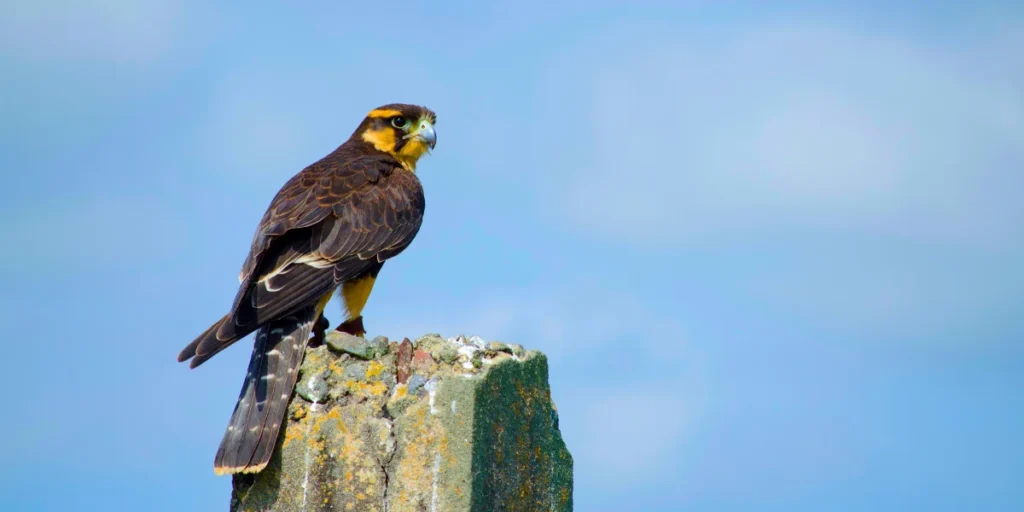
Appearance
The Aplomado Falcon is a sleek and elegant bird of prey with a long tail and pointed wings. It has a striking black facial mask, contrasted by a white line over the eyes. Its upperparts are slate gray, while its underparts are pale with a distinct black band across the belly. The thighs and legs are rich reddish-brown, giving the bird a striking appearance. Both males and females have similar plumage, but females tend to be slightly larger.
Migration Habits
Aplomado Falcons are largely non-migratory, although some populations may make short-distance movements in response to prey availability. In their range, which extends from the southern United States through Central and South America, they are more commonly found year-round. They are considered rare in the U.S., with breeding populations primarily reintroduced in southern Texas and parts of New Mexico. They are not typically found in Florida, though they may be spotted occasionally as rare vagrants.
Nesting
Unlike many other falcons, Aplomado Falcons do not build their own nests. Instead, they reuse abandoned nests of other birds, particularly those of crows, hawks, or even herons. They may also nest on cliffs or in tall cacti in more arid regions. Females lay 2-3 eggs, which are incubated for about 30-32 days. Both parents participate in raising the young, which fledge after about 5-6 weeks.
Feeding Behavior
Aplomado Falcons are swift and agile hunters that prey primarily on small birds, often catching them in mid-air with incredible precision. They also hunt large insects, small mammals, and occasionally reptiles. These falcons often hunt cooperatively in pairs, using their speed and agility to chase down and capture prey. Their long tail and pointed wings give them excellent maneuverability, allowing them to make tight turns during high-speed chases.
Behavior and Personality
Aplomado Falcons are known for their fast and acrobatic flight. They are often seen hunting in pairs, a unique behavior among falcons, allowing them to coordinate attacks on prey. They are territorial and will defend their nesting and hunting areas aggressively. Their calls are sharp and repetitive, often heard during social interactions or when defending territory. Aplomado Falcons are curious and will often explore new environments, showing intelligence and adaptability.
Habitat
Aplomado Falcons prefer open habitats such as savannas, grasslands, deserts, and coastal prairies. They are particularly drawn to areas with scattered trees or tall cacti for nesting. In the U.S., their range has historically included the southwestern deserts, though habitat loss has limited their populations. Conservation efforts have been focused on restoring their range in southern Texas and New Mexico. These birds are not typically found in Florida, but they can adapt well to open areas where prey is abundant.
| Category | Details |
|---|---|
| Status | Near Threatened globally; Endangered in the U.S. (reintroduced populations) |
| State Status | Rare in the U.S., mainly in Texas and New Mexico; not typically found in Florida |
| Wingspan | 89-102 cm (35-40 in) |
| Sound | Sharp, repetitive “klee-klee-klee” calls |
| Appearance | Slate gray upperparts, pale underparts with black belly band, black facial mask with white stripe, reddish-brown thighs |
7. Kites: Graceful Aerial Hunters
Kites are known for their elegant, soaring flight and specialized hunting techniques. These slender, graceful birds are common in Florida’s open landscapes and wetlands.
Swallow-tailed Kite (Elanoides forficatus)
Size: 50-64 cm (19.7-25.2 in)
Weight: 370-600 g (13.1-21.2 oz)
Lifespan: 6-12 years in the wild
Diet: Insects, small mammals, reptiles, amphibians, and small birds
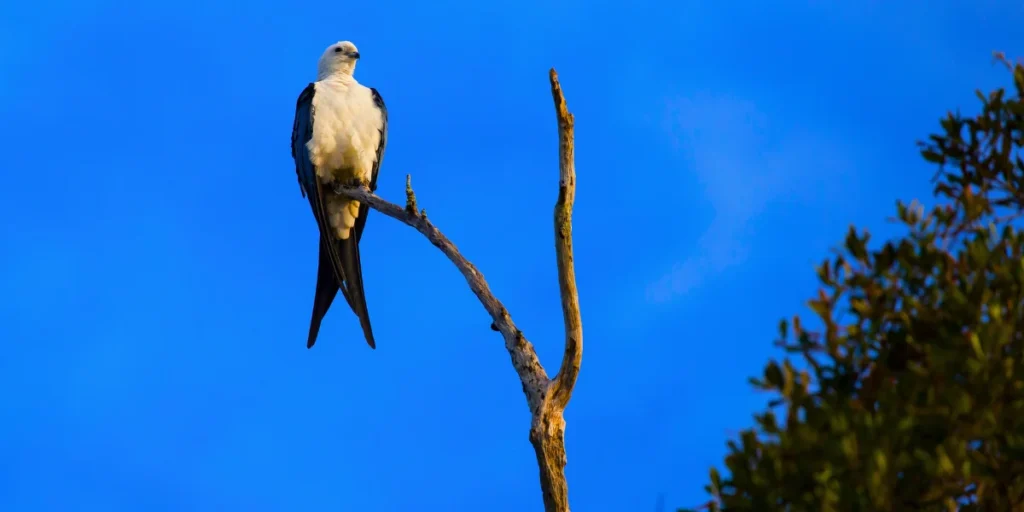
Appearance
The Swallow-tailed Kite is a graceful, slender raptor with striking black and white plumage. Its head, neck, and underparts are bright white, while its wings and deeply forked tail are glossy black. The long, deeply forked tail gives this bird an elegant appearance in flight, and it uses it to make quick, agile turns while hunting. Its long wings, which make up most of its body length, are sharply pointed, making it a master of aerial maneuvering.
Migration Habits
Swallow-tailed Kites are migratory birds, breeding in the southeastern United States, including Florida, and migrating to Central and South America for the winter. They begin their migration south in late summer and return in early spring. During migration, they are often seen gliding effortlessly in large groups, taking advantage of thermals to travel great distances with minimal effort.
Nesting
Swallow-tailed Kites build their nests in the crowns of tall trees, typically near swamps or rivers. Their nests are constructed from sticks and lined with softer materials like moss and leaves. They are often located in remote areas, away from human activity. Females lay 1-3 eggs, and both parents participate in incubating the eggs and feeding the young. The chicks fledge after about 5-6 weeks but remain dependent on their parents for several more weeks.
Feeding Behavior
Swallow-tailed Kites are aerial hunters, feeding primarily on flying insects, which they catch in flight with their talons. They also feed on small vertebrates, such as frogs, lizards, and small birds, which they snatch from trees or the ground. Their hunting is characterized by graceful gliding and swooping maneuvers, often performed high above forests and wetlands. They can spend hours soaring without flapping their wings, scanning the ground and air for prey.
Behavior and Personality
Swallow-tailed Kites are known for their effortless, buoyant flight, which allows them to cover vast distances while foraging. They are social birds and are often seen flying in groups, especially during migration. Despite their impressive size, they are not aggressive and generally avoid confrontation with other birds. Their vocalizations are soft and high-pitched, often heard during social interactions or while foraging. These birds are most active during the day, especially in the early morning when they hunt for insects and small prey.
Habitat
Swallow-tailed Kites prefer open, forested habitats near water, such as swamps, rivers, and wetlands. They require tall trees for nesting and open areas for hunting. In Florida, they are commonly seen gliding over forests and marshes, particularly in central and southern parts of the state. Their presence is often a sign of healthy ecosystems, as they rely on large tracts of undisturbed forest and wetland for nesting and foraging.
| Category | Details |
|---|---|
| Status | Least Concern (globally), but declining in some parts of the U.S. due to habitat loss |
| State Status | Common in Florida during the breeding season (spring and summer) |
| Wingspan | 120-136 cm (47-53 in) |
| Sound | Soft, high-pitched whistles |
| Appearance | White head and body, black wings and tail, deeply forked tail |
Mississippi Kite (Ictinia mississippiensis)
Size: 34-37 cm (13.4-14.6 in)
Weight: 216-269 g (7.6-9.5 oz)
Lifespan: 8-10 years in the wild
Diet: Insects, small birds, reptiles, and amphibians
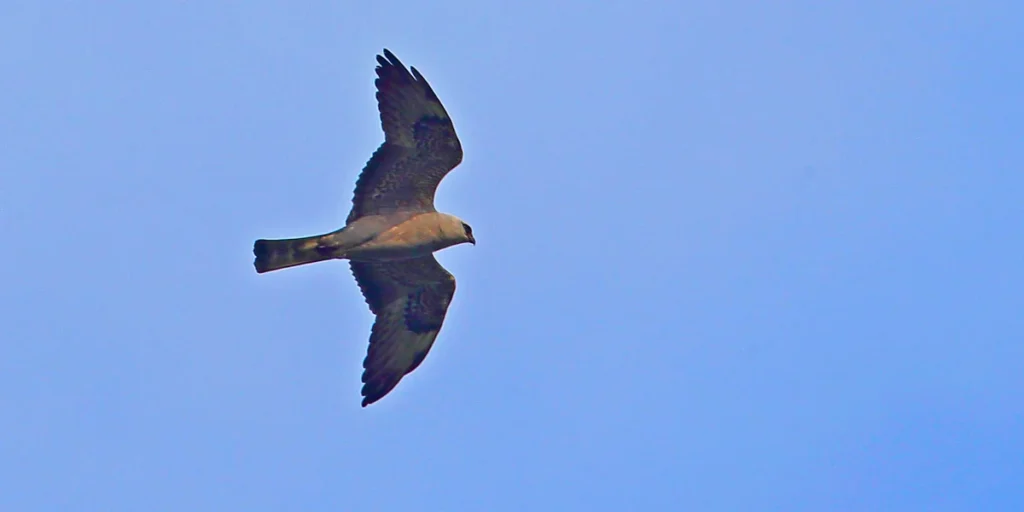
Appearance
The Mississippi Kite is a sleek and elegant raptor with a predominantly soft gray body and darker wings. Adults have a pale gray head, dark gray wings and back, and a lighter gray underside. Their long, pointed wings and slightly forked tail make them agile fliers. Juveniles are streaked brown with a more mottled appearance and gradually acquire the adult plumage as they mature. The birds have red eyes and black tails, giving them a striking appearance in flight.
Migration Habits
Mississippi Kites are long-distance migrants, traveling from their breeding grounds in the southern and central United States to wintering areas in South America, primarily in Argentina and Brazil. They migrate in groups, often seen soaring in flocks during their journey, using thermals to conserve energy as they travel. In Florida, they are mostly present during the breeding season, from late spring to early fall, before heading south for the winter.
Nesting
Mississippi Kites build small, shallow nests high up in trees, typically in wooded areas near open fields or wetlands. The nest is made of sticks and lined with softer materials like leaves and moss. Females lay 1-3 eggs, and both parents take turns incubating the eggs for about 30 days. The parents are attentive and protective, feeding the chicks for several weeks after they fledge, which usually happens around 4-5 weeks after hatching.
Feeding Behavior
Mississippi Kites are primarily insectivores, feeding on large flying insects such as cicadas, grasshoppers, and dragonflies. They are known for their graceful aerial acrobatics, catching insects mid-air with incredible agility. They also feed on small birds, reptiles, and amphibians when available. Kites often forage in groups, soaring over open areas and swooping down to snatch prey from the air or off the ground. Their long, pointed wings and tail allow them to maneuver with precision during flight.
Behavior and Personality
Mississippi Kites are highly social birds, often seen flying in small groups or roosting together in large numbers. They are known for their calm and gentle nature, both toward humans and other birds. During migration, they form large flocks and are often observed soaring in graceful circles high above the ground. Their calls are soft and high-pitched, often used to communicate with mates and juveniles. Mississippi Kites are most active during the day, particularly in the late afternoon when they hunt for insects.
Habitat
Mississippi Kites prefer open woodlands, savannas, and areas near wetlands or rivers. They are commonly found near agricultural fields, pastures, and other open habitats where flying insects are abundant. In Florida, they are often seen in the summer, soaring over forests, fields, and wetlands. They require tall trees for nesting and open spaces for foraging, and their presence is a sign of healthy ecosystems with abundant insect populations.
| Category | Details |
|---|---|
| Status | Least Concern |
| State Status | Common summer visitor in Florida |
| Wingspan | 87-102 cm (34-40 in) |
| Sound | High-pitched, soft whistles |
| Appearance | Soft gray body, darker wings, pale gray head, black tail, red eyes |
Snail Kite (Rostrhamus sociabilis)
Size: 36-39 cm (14.2-15.3 in)
Weight: 360-570 g (12.7-20.1 oz)
Lifespan: 6-12 years in the wild
Diet: Primarily apple snails, but occasionally other mollusks and small aquatic prey
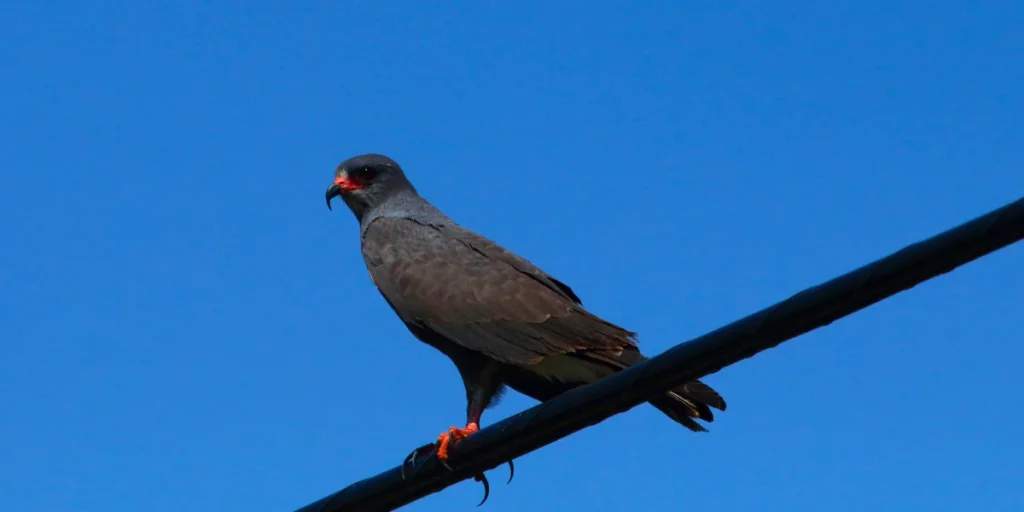
Appearance
The Snail Kite is a medium-sized raptor with a distinctive slender, curved beak designed specifically for extracting snails from their shells. Males are dark slate-gray with red eyes and legs, while females and juveniles are brown with streaked underparts and pale facial markings. Both sexes have broad, rounded wings and a long, slightly rounded tail with white patches near the base. The curved bill is the most prominent feature, perfectly suited for feeding on snails.
Migration Habits
Snail Kites are largely non-migratory, remaining in their home territories year-round. In Florida, they are permanent residents, particularly in the central and southern parts of the state. They do, however, move locally in response to changes in water levels and the availability of their primary food source, the apple snail. During periods of drought, they may move to other wetlands in search of food.
Nesting
Snail Kites typically nest in low shrubs or small trees near freshwater wetlands, lakes, or marshes where apple snails are abundant. The nest is made of sticks and lined with soft plant material. Females lay 1-4 eggs, which are incubated for about 26-28 days. Both parents share the responsibility of incubating the eggs and feeding the chicks. The young fledge at around 6-7 weeks but continue to depend on their parents for food for several more weeks.
Feeding Behavior
Snail Kites are highly specialized feeders, relying almost exclusively on apple snails for their diet. They use their curved beaks to expertly extract the snails from their shells. They hunt by flying low over wetlands, scanning the water for snails that are near the surface or perched on aquatic vegetation. Once they spot a snail, they swoop down and pluck it from the water with their talons. Though they mainly feed on apple snails, they occasionally eat other small aquatic prey, such as crayfish or smaller mollusks, if snails are scarce.
Behavior and Personality
Snail Kites are known for their graceful, slow flight as they glide low over wetlands in search of snails. They are relatively social birds and are often seen in small groups, particularly around abundant food sources. Despite their specialized diet, they are adaptable and will move to different wetlands if conditions change. Their calls are harsh and repetitive, often heard during interactions between mates or when defending their nests. They are most active during the day, especially in the morning and late afternoon.
Habitat
Snail Kites are almost exclusively found in freshwater wetlands, marshes, and shallow lakes where apple snails are abundant. In Florida, they are most commonly seen in the Everglades, around Lake Okeechobee, and other large wetland areas in the central and southern parts of the state. The availability of wetlands with abundant snail populations is crucial for their survival. Habitat loss and changes in water management practices have had a significant impact on Snail Kite populations, making their conservation a priority in Florida.
| Category | Details |
|---|---|
| Status | Endangered (in the U.S.) |
| State Status | Resident in Florida, primarily in central and southern regions |
| Wingspan | 109-116 cm (42.9-45.7 in) |
| Sound | Harsh, repetitive calls |
| Appearance | Males: dark slate-gray; Females: brown with streaked underparts, curved bill, long wings, white tail patches |
White-tailed Kite (Elanus leucurus)
Size: 32-38 cm (12.6-15 in)
Weight: 300-360 g (10.6-12.7 oz)
Lifespan: 6-15 years in the wild
Diet: Primarily small mammals, especially voles, but also birds, reptiles, and large insects
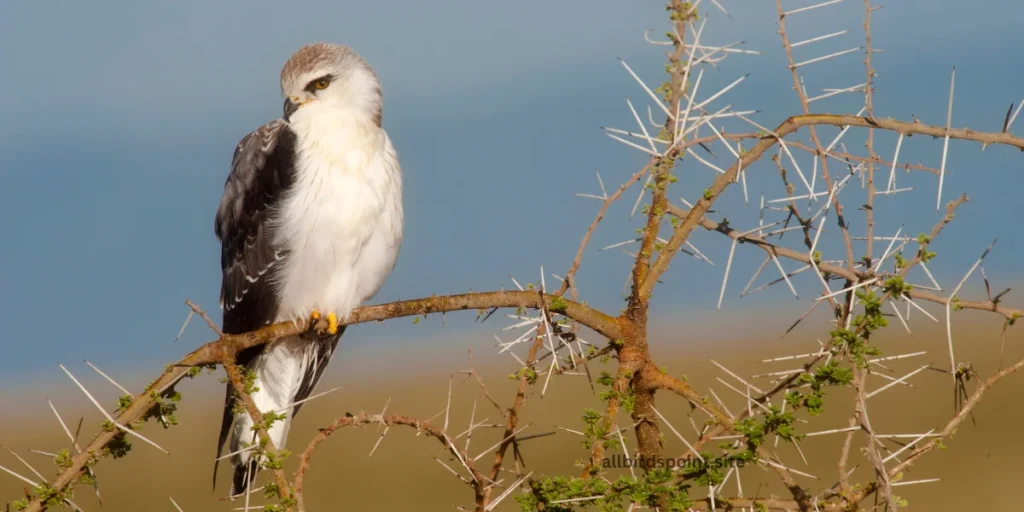
Appearance
The White-tailed Kite is an elegant raptor with a striking appearance. It has predominantly white underparts, head, and tail, while its upperparts are pale gray. The wings are gray with black shoulder patches that are visible when perched or in flight. The kite’s bright red eyes stand out against its white face, giving it a piercing look. Its long, pointed wings and tail give it a buoyant, graceful flight, and its slender body and sharp talons are designed for swift hunting.
Migration Habits
White-tailed Kites are generally non-migratory, remaining in their territories year-round, although they may move short distances in response to changes in prey availability. They are primarily found in the western United States and parts of Central and South America, but they are also seen in southern Florida, where they are permanent residents in some areas.
Nesting
White-tailed Kites build small, cup-shaped nests in the tops of trees, particularly in open woodlands or near the edges of fields. They use sticks and softer materials such as grass and leaves to construct their nests. Females lay 3-5 eggs, which are incubated for about 28-32 days. Both parents help feed the young, which fledge after about 4-5 weeks. White-tailed Kites are territorial and will defend their nesting areas from other predators and birds.
Feeding Behavior
White-tailed Kites are specialized hunters, primarily feeding on small mammals, particularly voles, mice, and other rodents. They are also known to hunt birds, reptiles, and large insects when small mammals are scarce. These kites have a unique hunting style: they hover in place, similar to a helicopter, scanning the ground below for prey. Once prey is spotted, they dive down swiftly to capture it with their talons. Their hovering flight is a distinct and graceful sight, often seen over grasslands and fields.
Behavior and Personality
White-tailed Kites are calm, patient hunters and are often seen hovering over open fields while searching for prey. They are social birds, especially during the non-breeding season, and may form small flocks. Their vocalizations include soft, high-pitched whistles, often heard between mates or when defending their territory. They are typically active during the day, particularly in the morning and late afternoon. Their flight is light and buoyant, making them highly maneuverable in the air.
Habitat
White-tailed Kites prefer open habitats such as grasslands, savannas, agricultural fields, and wetlands. They thrive in areas with ample open space for hunting and scattered trees for nesting. In Florida, they are found in the southern parts of the state, particularly in areas with open fields and low vegetation. Their reliance on small mammals, especially rodents, makes them a crucial predator in these ecosystems, helping to control rodent populations.
| Category | Details |
|---|---|
| Status | Least Concern (globally), but sensitive to habitat loss |
| State Status | Permanent resident in southern Florida |
| Wingspan | 99-110 cm (39-43.3 in) |
| Sound | Soft, high-pitched whistles |
| Appearance | White body and head, gray wings with black shoulder patches, bright red eyes, long pointed wings and tail |
Hook-billed Kite (Chondrohierax uncinatus)
Size: 38-51 cm (15-20 in)
Weight: 310-460 g (11-16 oz)
Lifespan: 8-12 years in the wild
Diet: Primarily tree snails, but also small reptiles and insects
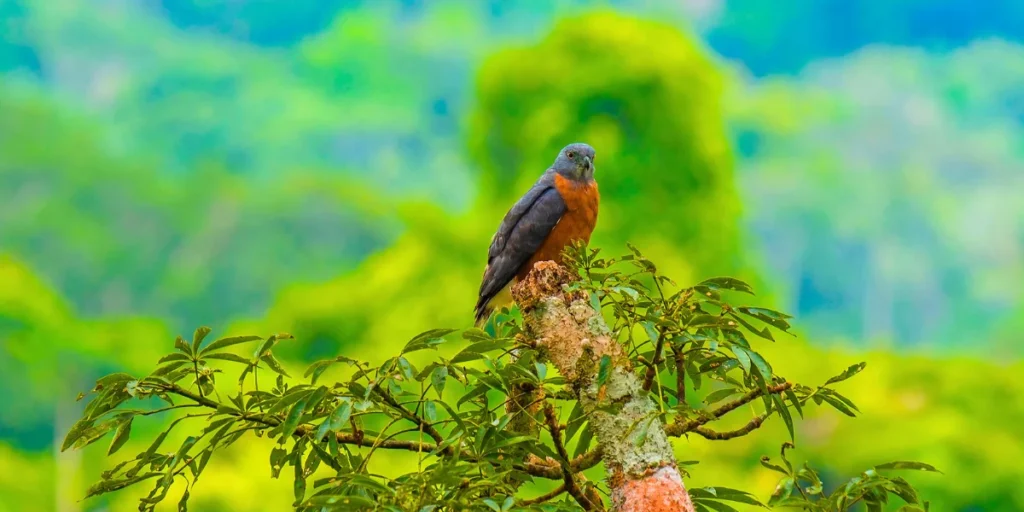
Appearance
The Hook-billed Kite is a medium-sized raptor with a distinctive, sharply curved beak, which it uses to extract snails from their shells. Males and females differ in appearance (sexual dimorphism). Males are usually slate gray with pale underparts, while females are browner with streaked underparts. Both sexes have long wings and a long, rounded tail, which helps them maneuver through dense forests. The kite’s signature hook-shaped bill is the most defining feature, perfectly suited for its specialized diet.
Migration Habits
Hook-billed Kites are mostly non-migratory, though they may move short distances locally in response to the availability of their primary food source—tree snails. They are typically found in tropical and subtropical forests in Central and South America, but there are occasional rare sightings in southern Florida. Their movements are more erratic than migratory, driven by environmental conditions rather than seasonal changes.
Nesting
Hook-billed Kites build their nests high in the canopy of dense forests, using twigs and leaves. They typically nest in areas close to their food source—forests rich in tree snails. Females lay 1-2 eggs, which are incubated for about 30 days. Both parents share the responsibility of feeding and raising the young. The chicks fledge at about 5-6 weeks but continue to rely on their parents for food for a while after leaving the nest.
Feeding Behavior
The Hook-billed Kite has a highly specialized diet, feeding almost exclusively on tree snails. Its unique, hooked bill allows it to pry snails from their shells with precision. In areas where tree snails are scarce, they may also consume small reptiles, amphibians, and insects. Hook-billed Kites are adept at gliding slowly through the forest, searching for snails on tree trunks and branches. Their foraging style is deliberate, and they often perch for long periods while scanning their surroundings for food.
Behavior and Personality
Hook-billed Kites are generally solitary birds, though they may sometimes be seen in pairs, particularly during the breeding season. They are secretive and elusive, often remaining hidden within the forest canopy. Their flight is slow and graceful, characterized by gliding and minimal wing flapping as they move through the forest in search of food. Their calls are soft and infrequent, consisting of high-pitched whistles. While they are shy and rarely aggressive, they are highly territorial during the nesting season and will defend their nests against intruders.
Habitat
Hook-billed Kites are typically found in tropical and subtropical forests, particularly in areas with dense vegetation and an abundance of tree snails. They prefer lowland forests, woodlands, and swampy areas where their primary food source is abundant. In Florida, they are extremely rare and are considered vagrants. Their core range extends from Mexico to South America, where they are more common in moist, humid forests.
| Category | Details |
|---|---|
| Status | Least Concern (globally), but rare in the U.S. |
| State Status | Rare vagrant in Florida |
| Wingspan | 76-99 cm (30-39 in) |
| Sound | Soft, high-pitched whistles |
| Appearance | Males: slate gray, Females: brown with streaked underparts, both with long wings and a distinctive hooked bill |
8. Conservation and the Future of Florida’s Raptors
Florida’s birds of prey face various threats, including habitat loss, pollution, and human encroachment. Conservation efforts are essential to protect their populations. Bald Eagles, for example, have made a remarkable recovery due to legal protections and habitat restoration. Other species, such as the Snail Kite and Swallow-tailed Kite, depend on the preservation of Florida’s wetlands for their survival. Continued support for conservation programs, including habitat restoration and public awareness, is crucial for ensuring the long-term survival of Florida’s raptors.
9. Conclusion
Florida’s raptors are among the state’s most captivating wildlife, representing strength, adaptability, and the intricate balance of nature. From the soaring Bald Eagles to the agile Peregrine Falcons and graceful Swallow-tailed Kites, these birds of prey are vital to maintaining the state’s ecosystems. By understanding and protecting these species, we ensure that Florida’s skies remain filled with these incredible hunters for generations to come.
FAQs
Q: What are some common birds of prey found in Florida?
A: Florida is home to a variety of birds of prey, including Bald Eagles, Red-tailed Hawks, Ospreys, Crested Caracaras, and Barn Owls, among others.
Q: Are Bald Eagles commonly seen in Florida?
A: Yes, Bald Eagles are commonly seen year-round in Florida, especially near large bodies of water such as lakes, rivers, and coastal areas.
Q: What do birds of prey in Florida typically eat?
A: Birds of prey in Florida eat a wide variety of food, including small mammals, birds, fish, reptiles, and insects, depending on the species. For example, Ospreys primarily eat fish, while Red-tailed Hawks and Bald Eagles feed on small mammals and birds.
Q: Are there any migratory birds of prey in Florida?
A: Yes, several species of birds of prey in Florida, such as the Broad-winged Hawk and Swallow-tailed Kite, are migratory, spending winters in Florida and migrating to northern areas for breeding.
Q: What is unique about the Crested Caracara?
A: The Crested Caracara is unique for its scavenging habits, often feeding on carrion like vultures. It is found in open habitats and agricultural areas in central and southern Florida.
Q: Where can I spot birds of prey in Florida?
A: Birds of prey can be spotted across various habitats in Florida, including wetlands, forests, coastlines, and open grasslands. Popular bird-watching locations include the Everglades, Lake Okeechobee, and Merritt Island National Wildlife Refuge.
Q: Are any birds of prey in Florida endangered?
A: Yes, the Snail Kite is listed as endangered due to habitat loss and changes in water management, which affect the availability of its primary food source, apple snails.
Q: What adaptations do birds of prey have for hunting?
A: Birds of prey have sharp talons, powerful beaks, and excellent vision, allowing them to spot and capture prey efficiently. Some, like the Osprey, are specialized for catching fish, while others, like the Peregrine Falcon, are built for high-speed dives to catch birds mid-flight.
Q: Can I see owls in Florida?
A: Yes, Florida is home to several owl species, including the Great Horned Owl, Barred Owl, Eastern Screech-Owl, and Burrowing Owl. These owls can be found in forests, wetlands, and even urban areas.
Q: How do birds of prey contribute to the ecosystem in Florida?
A: Birds of prey play a critical role in Florida’s ecosystem by controlling populations of small mammals, birds, reptiles, and insects. They help maintain balance within their habitats and contribute to the overall health of the ecosystem.
